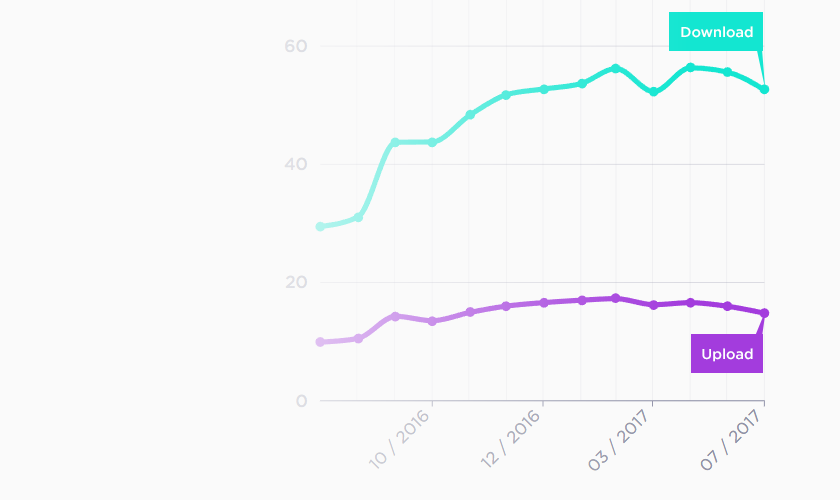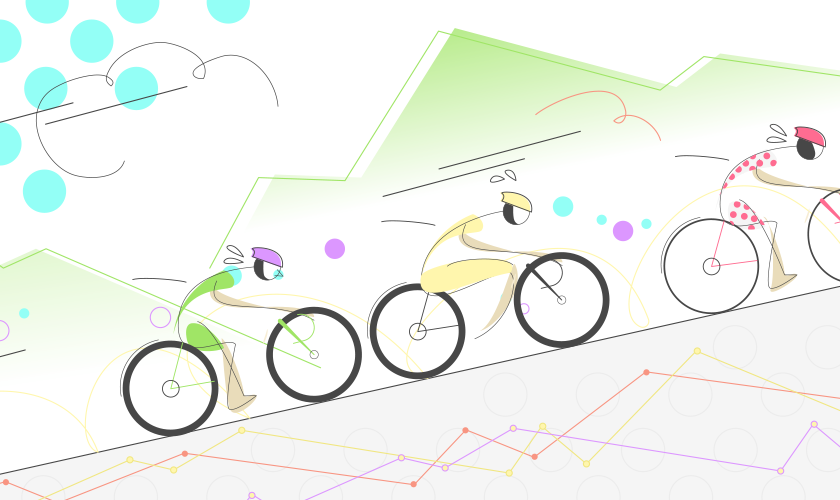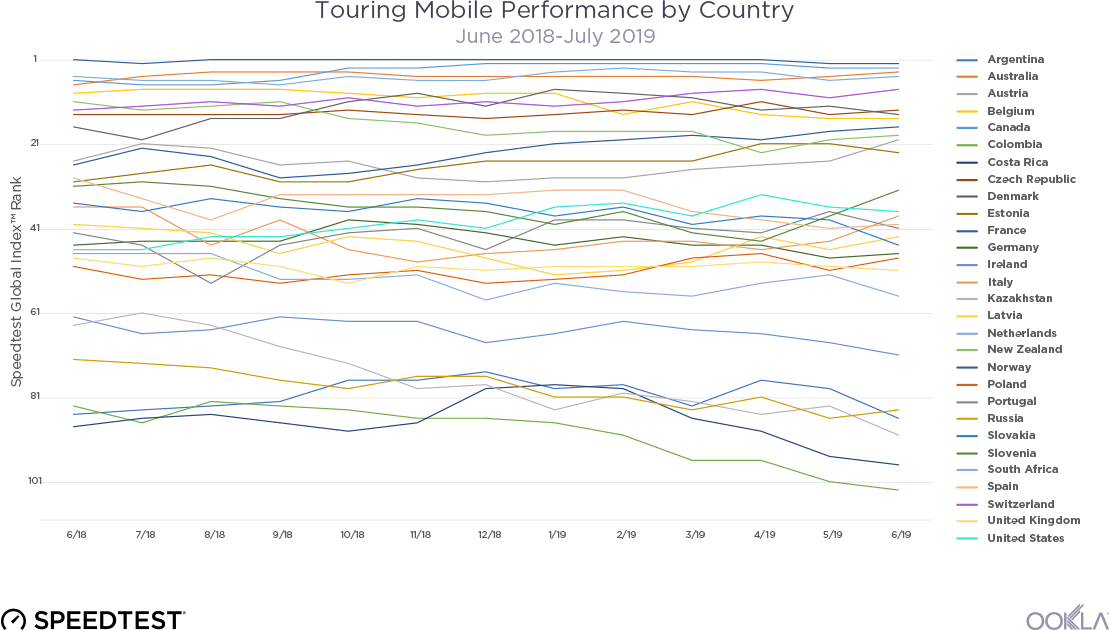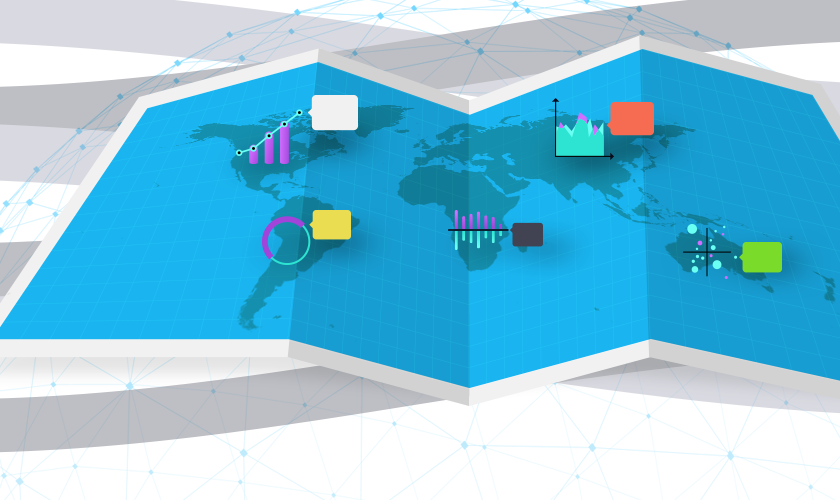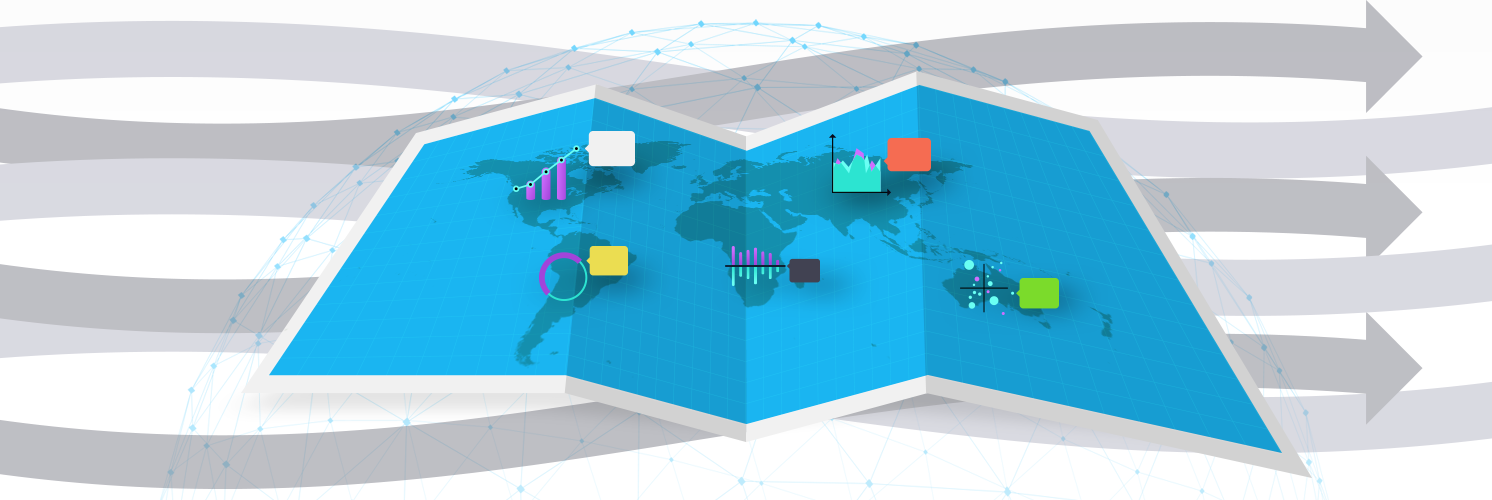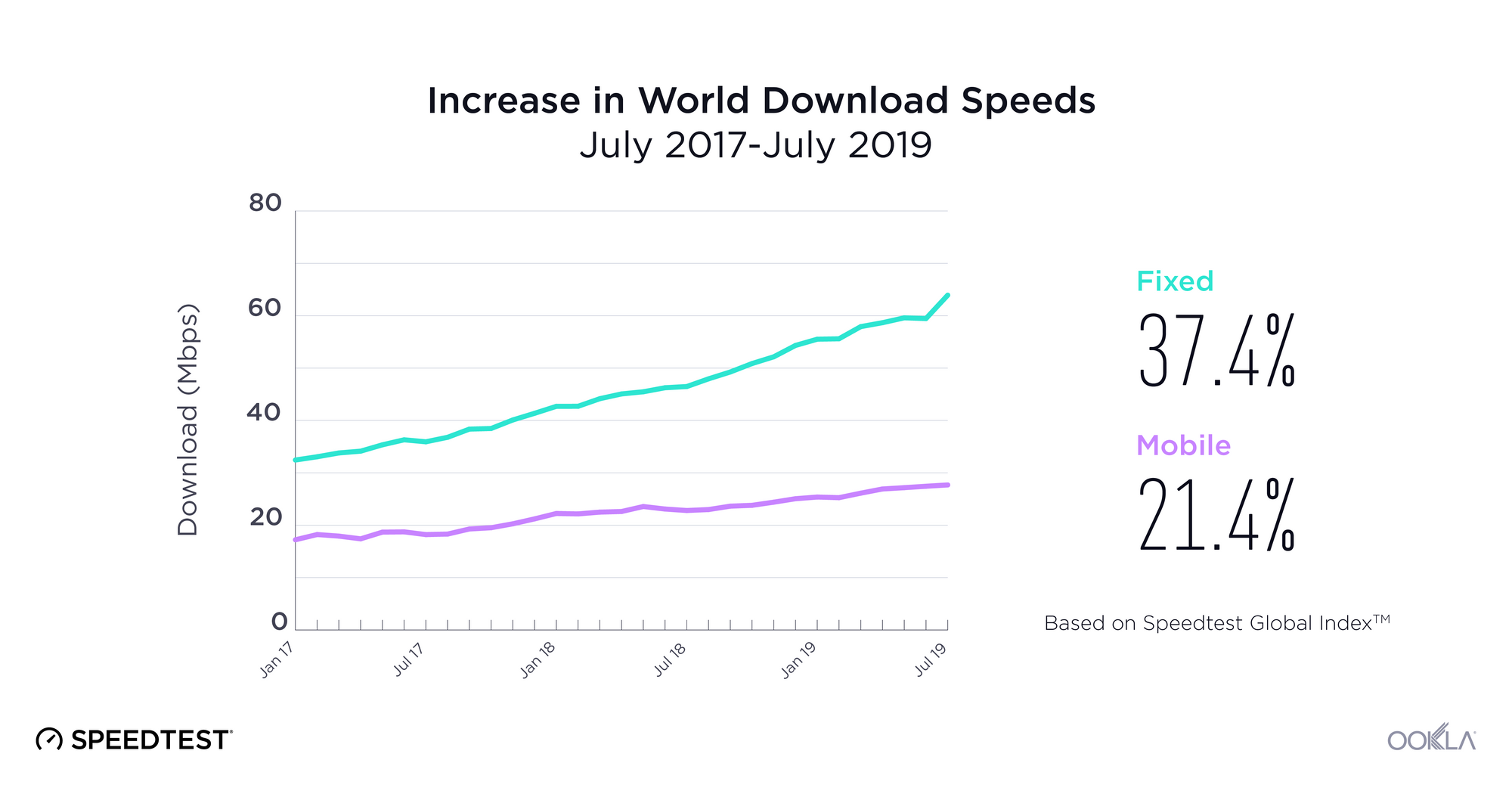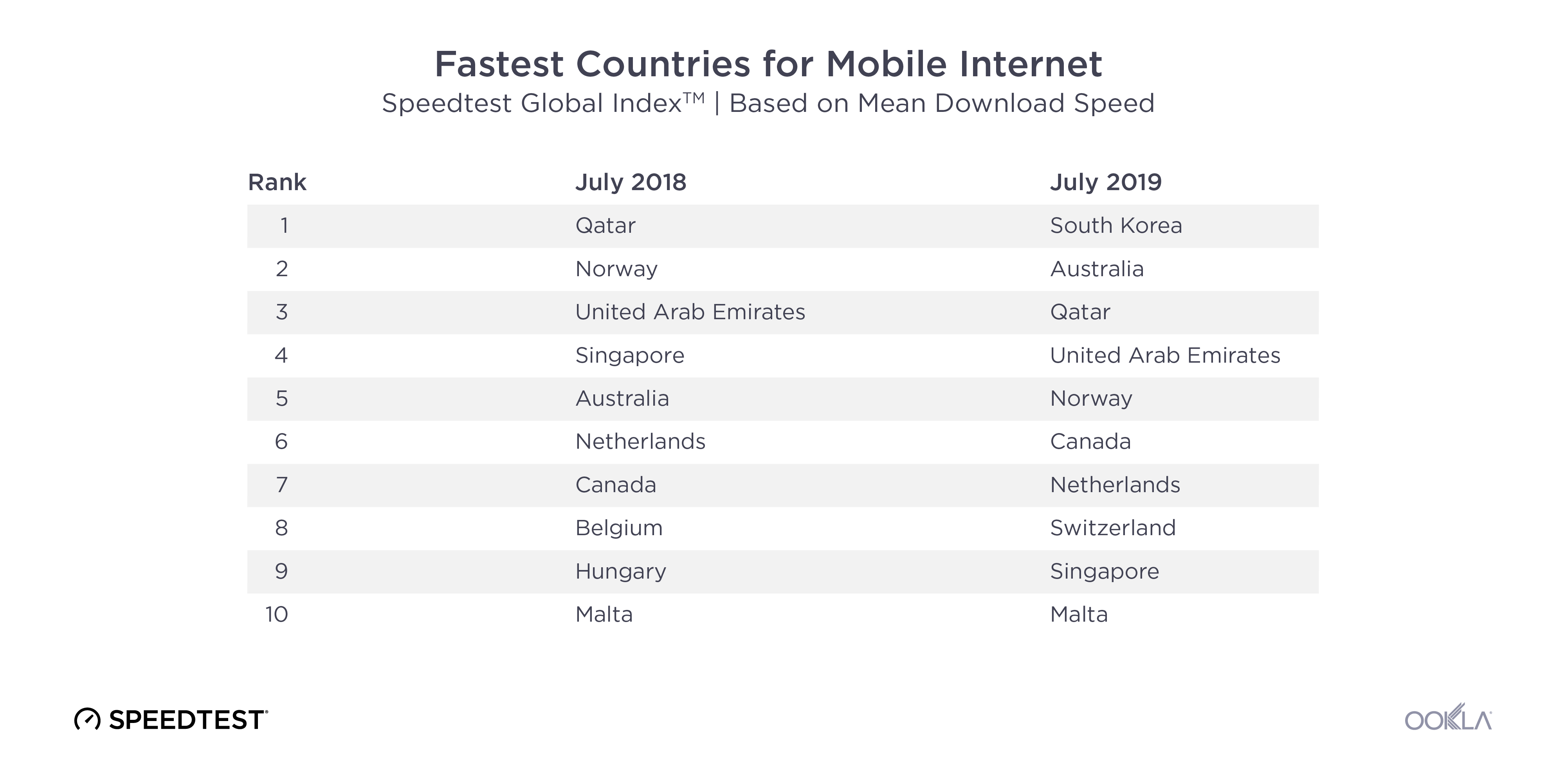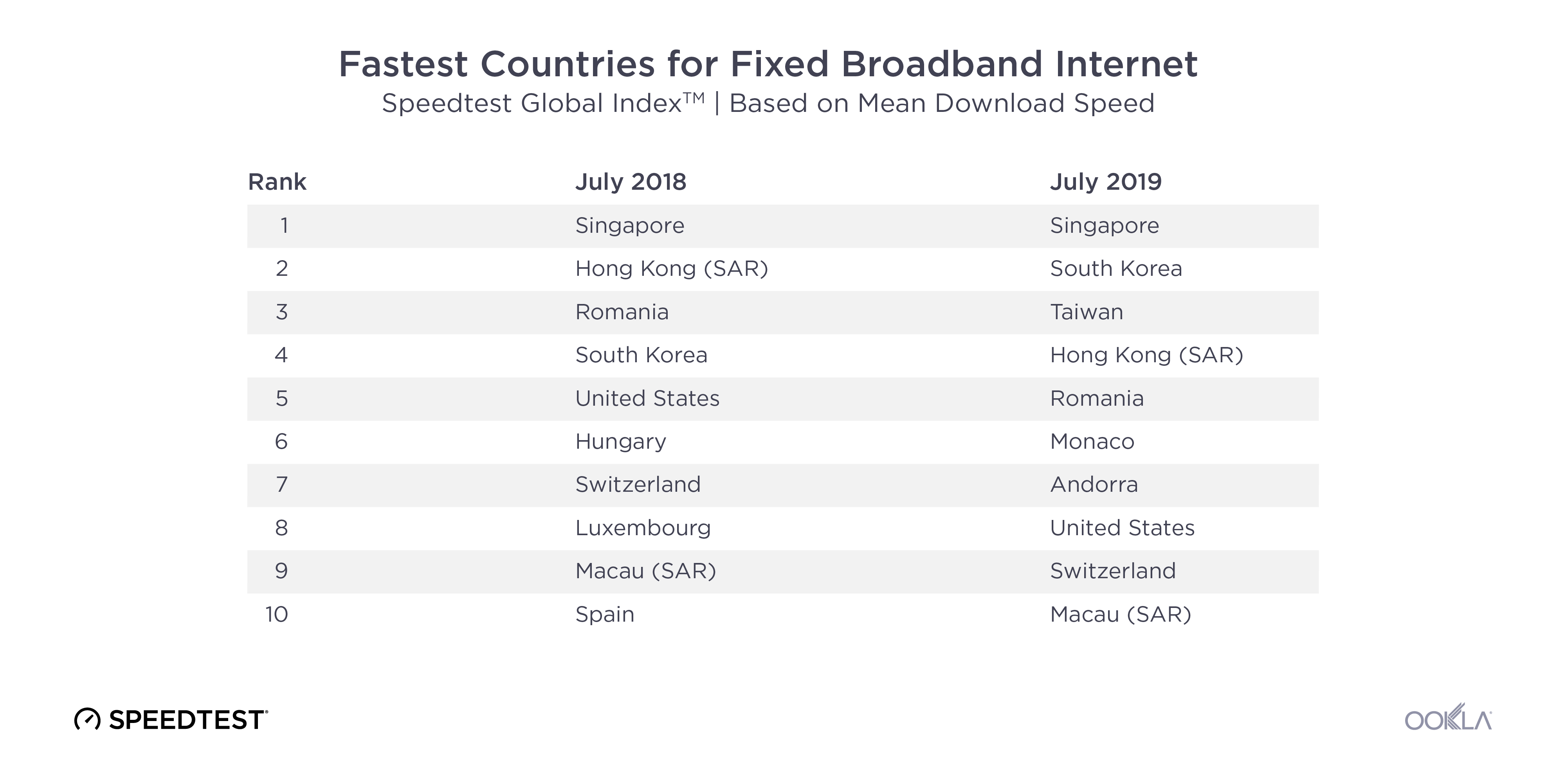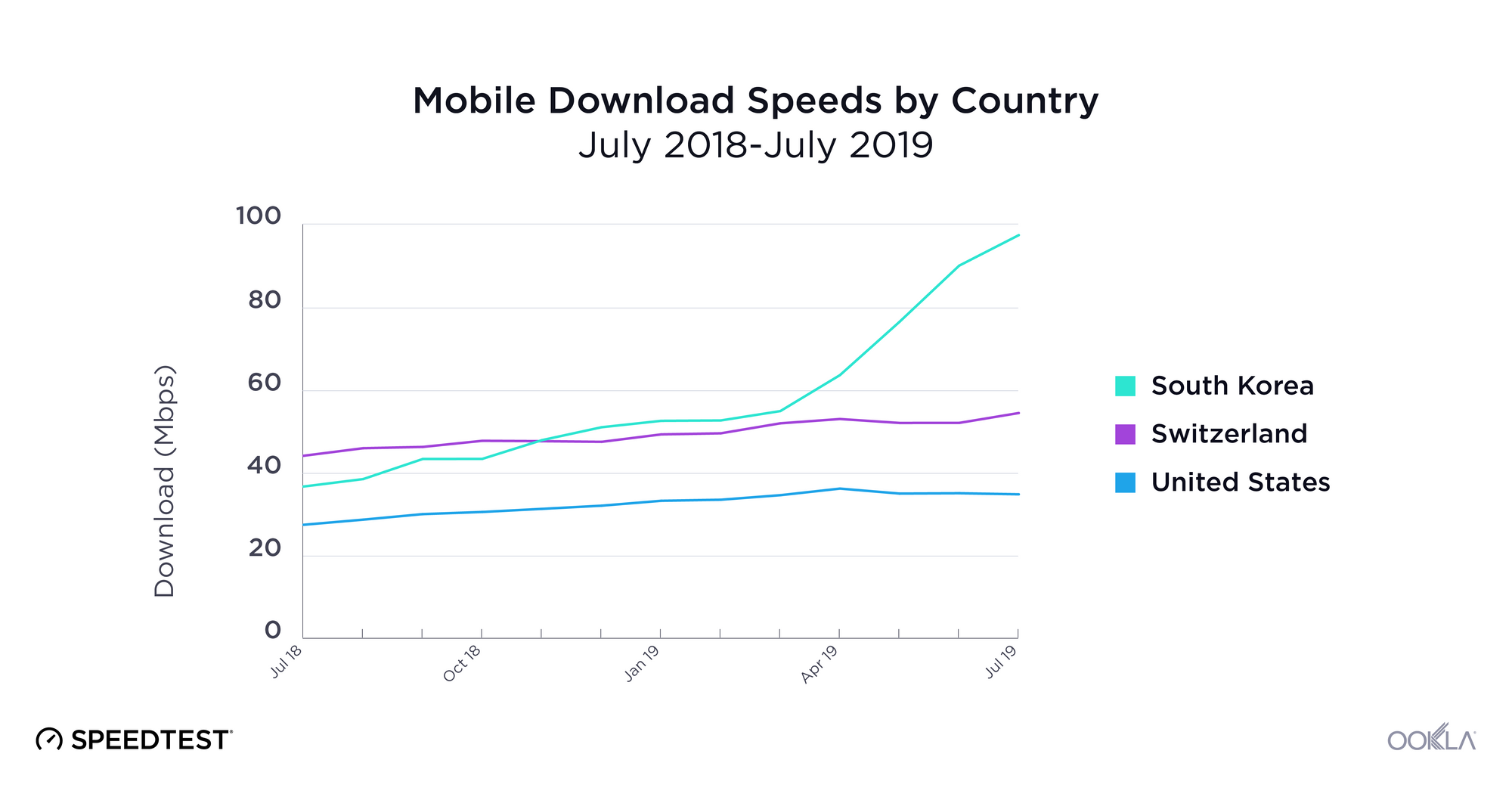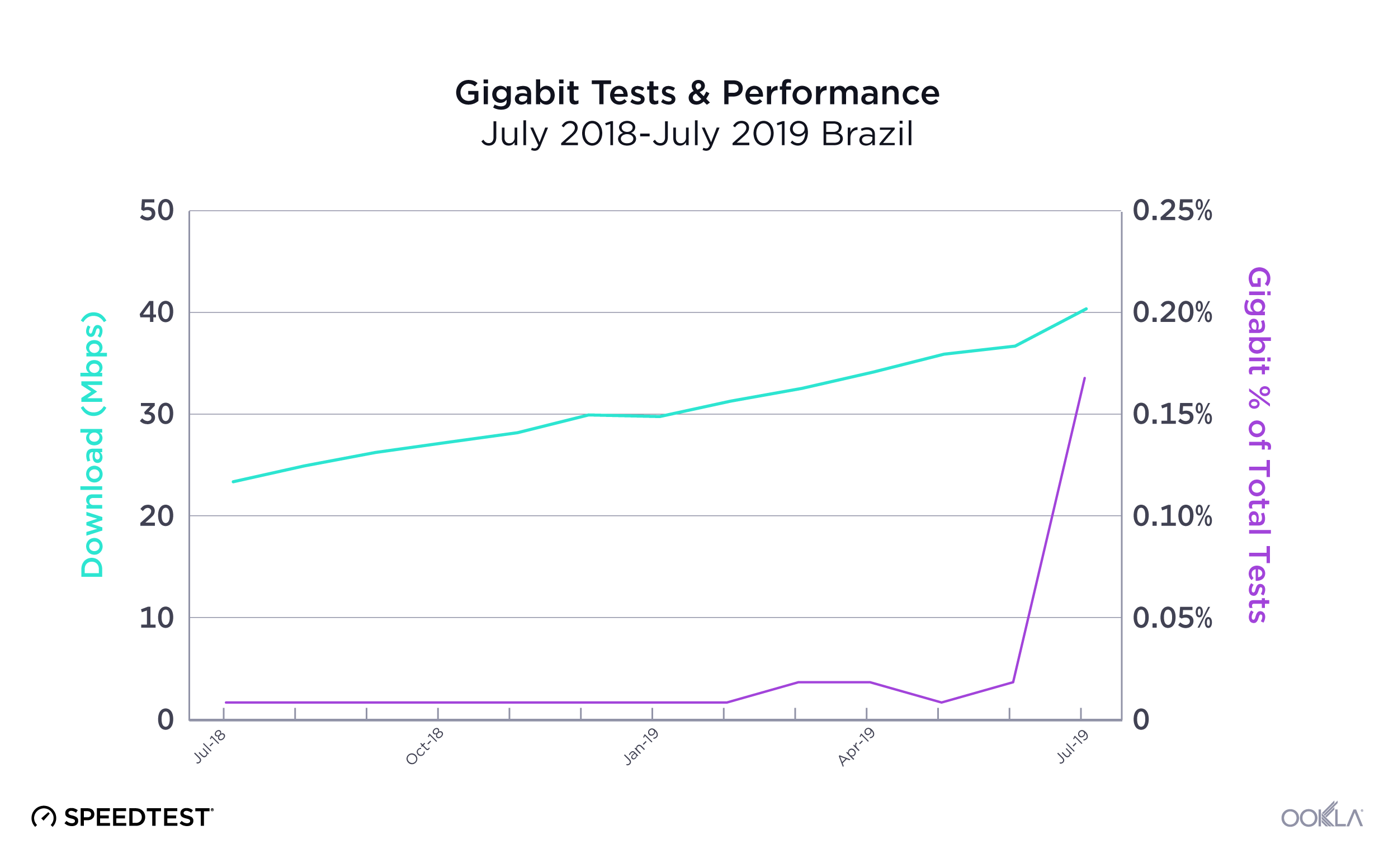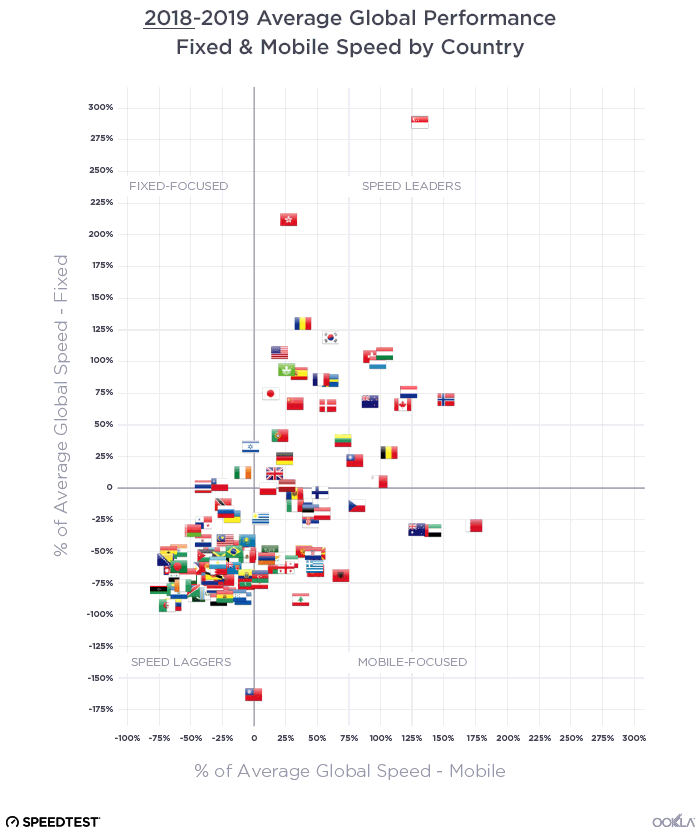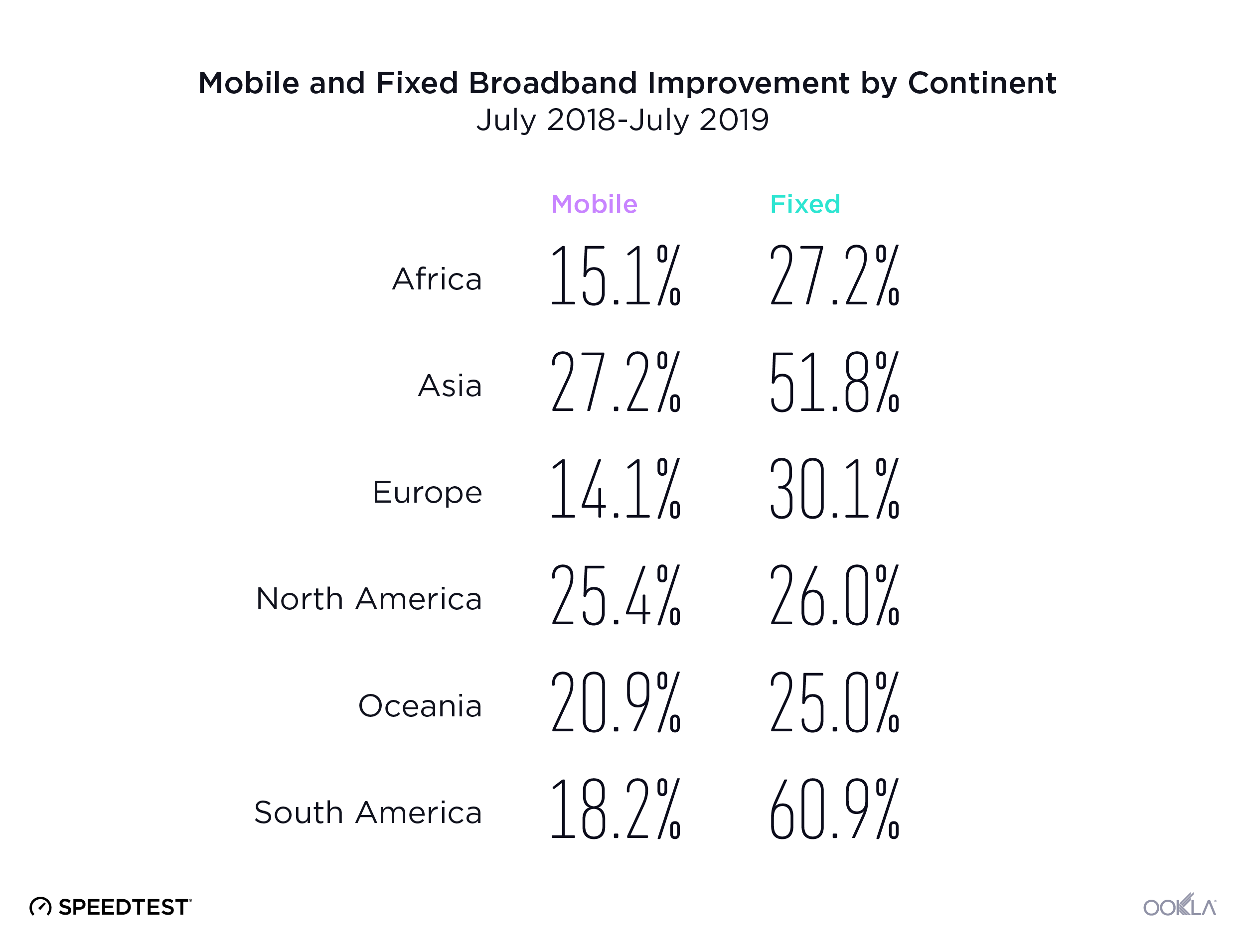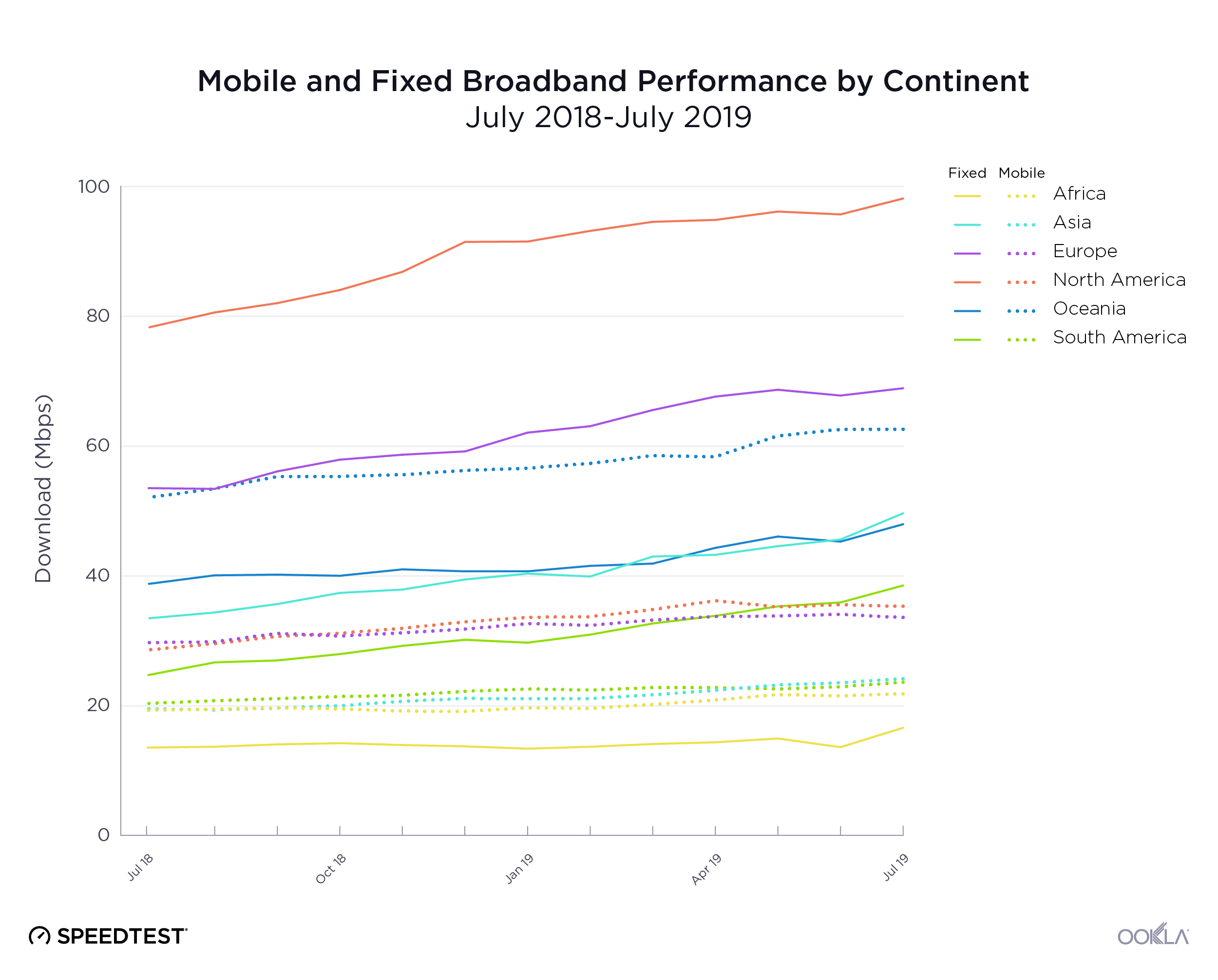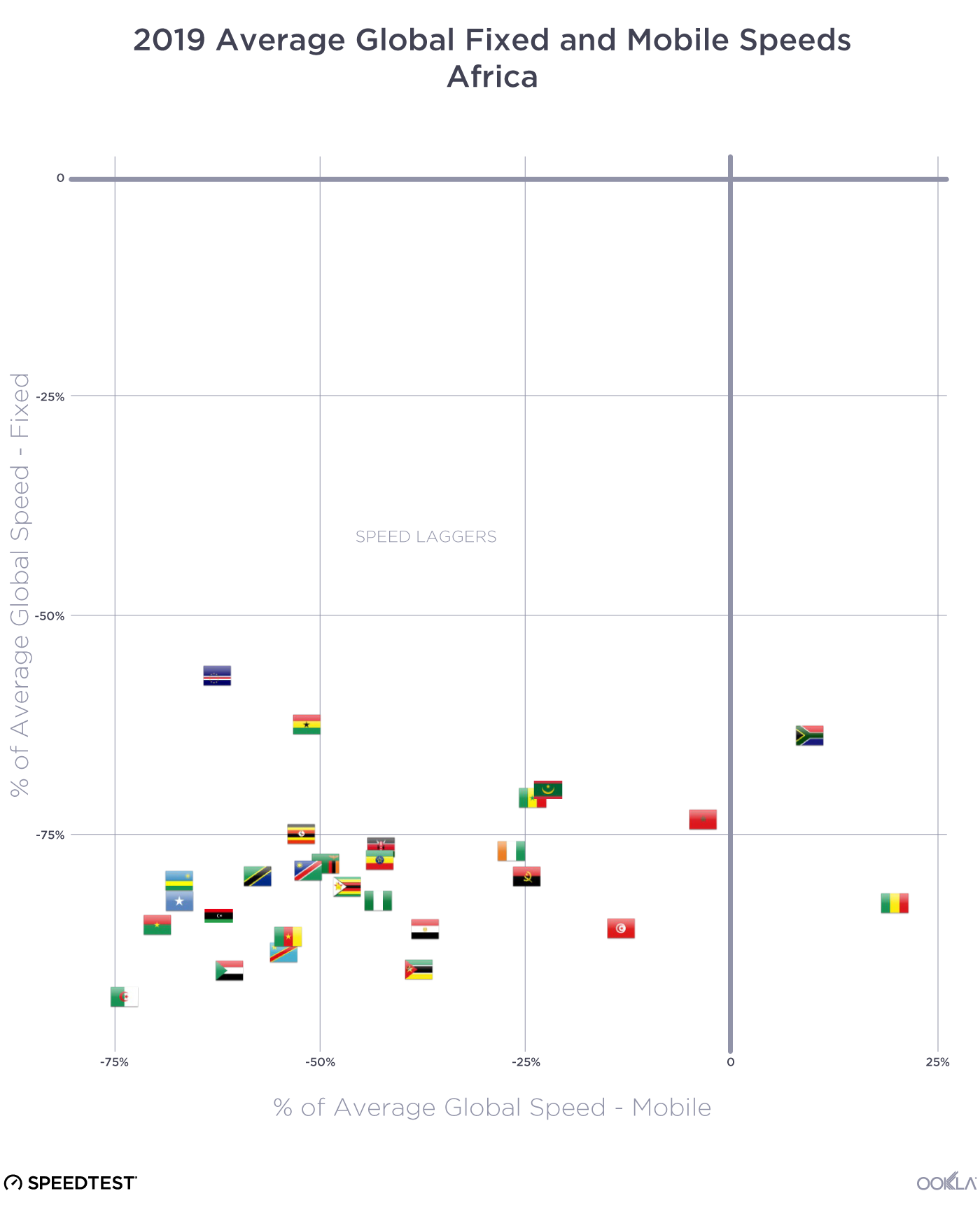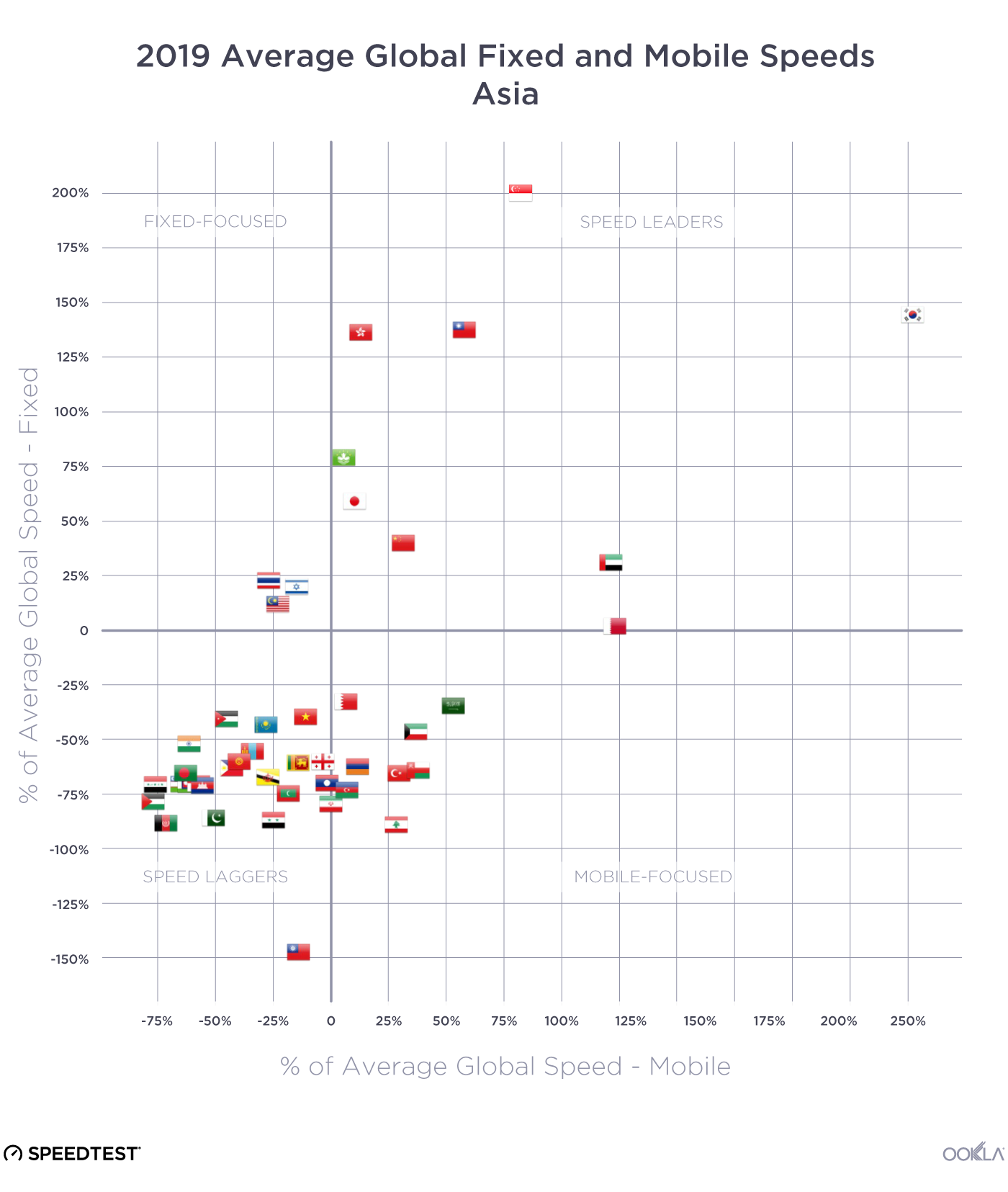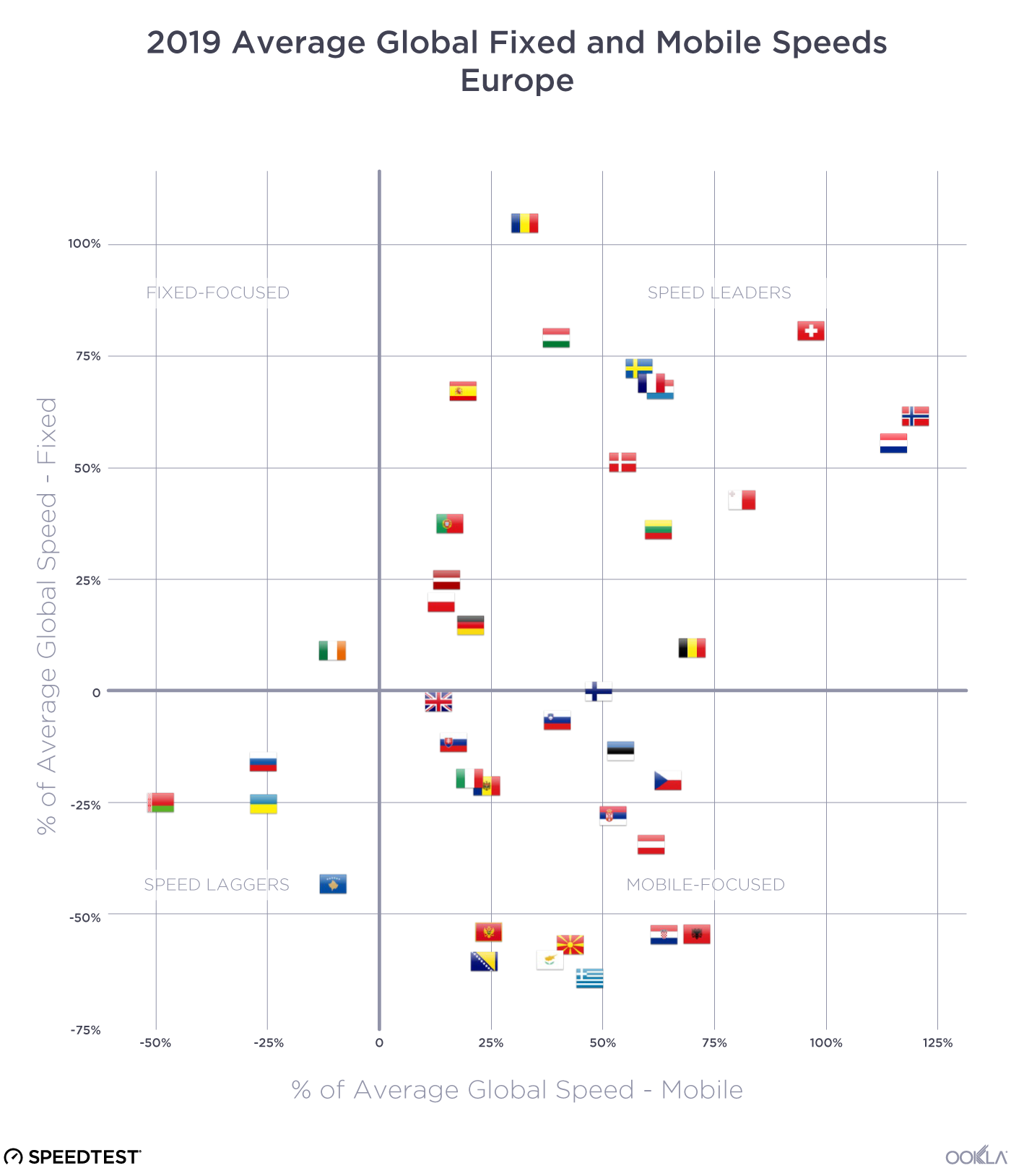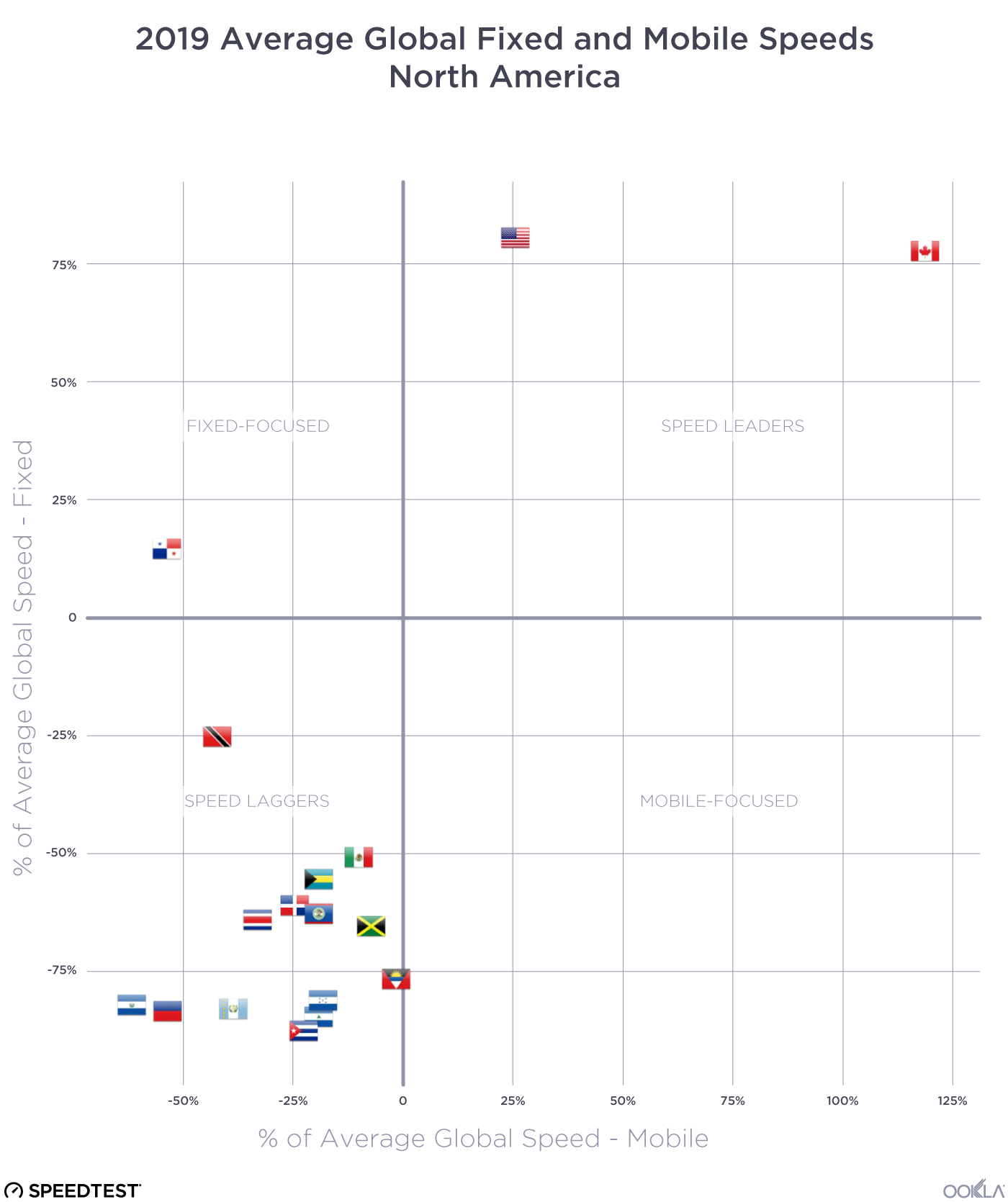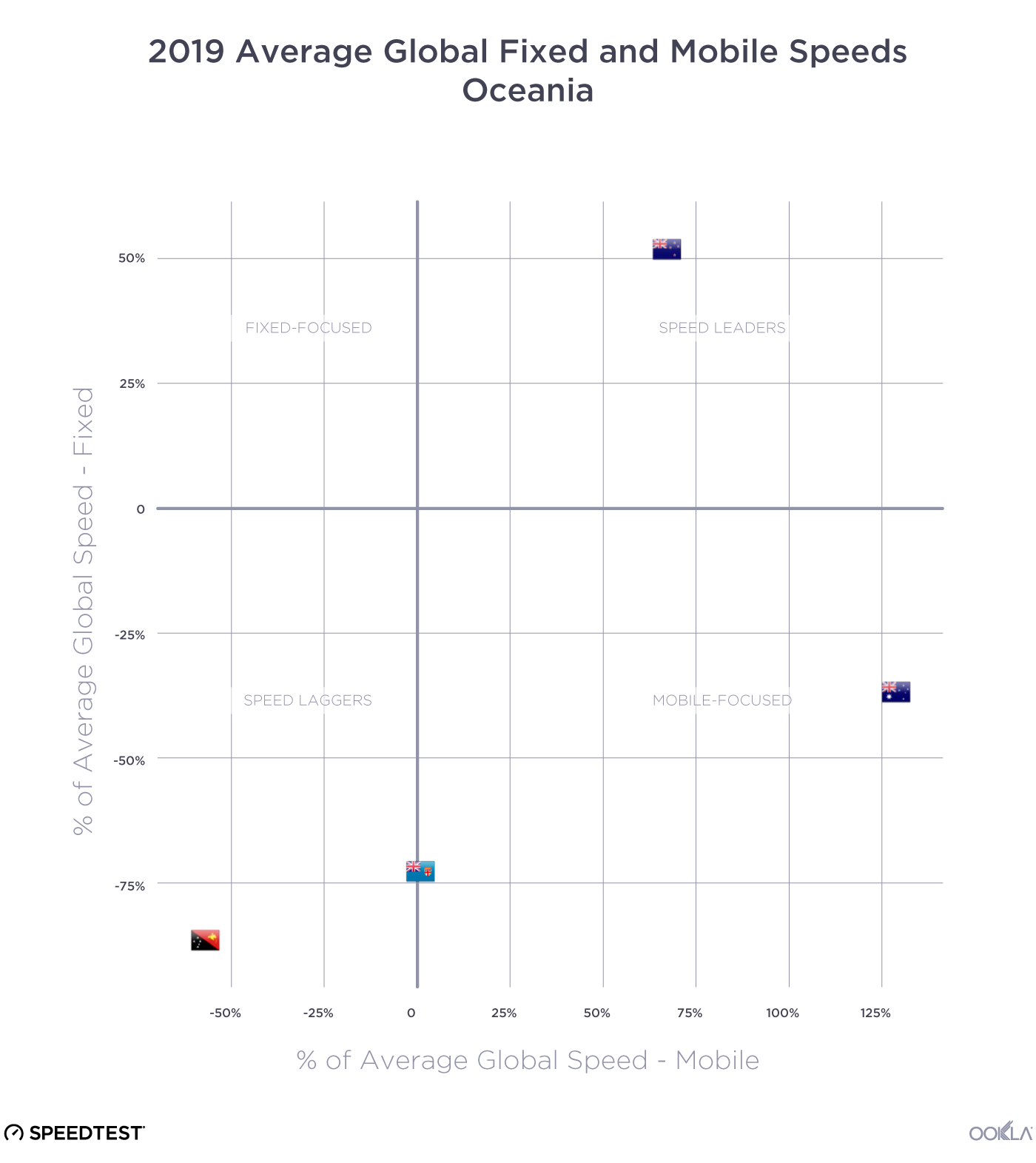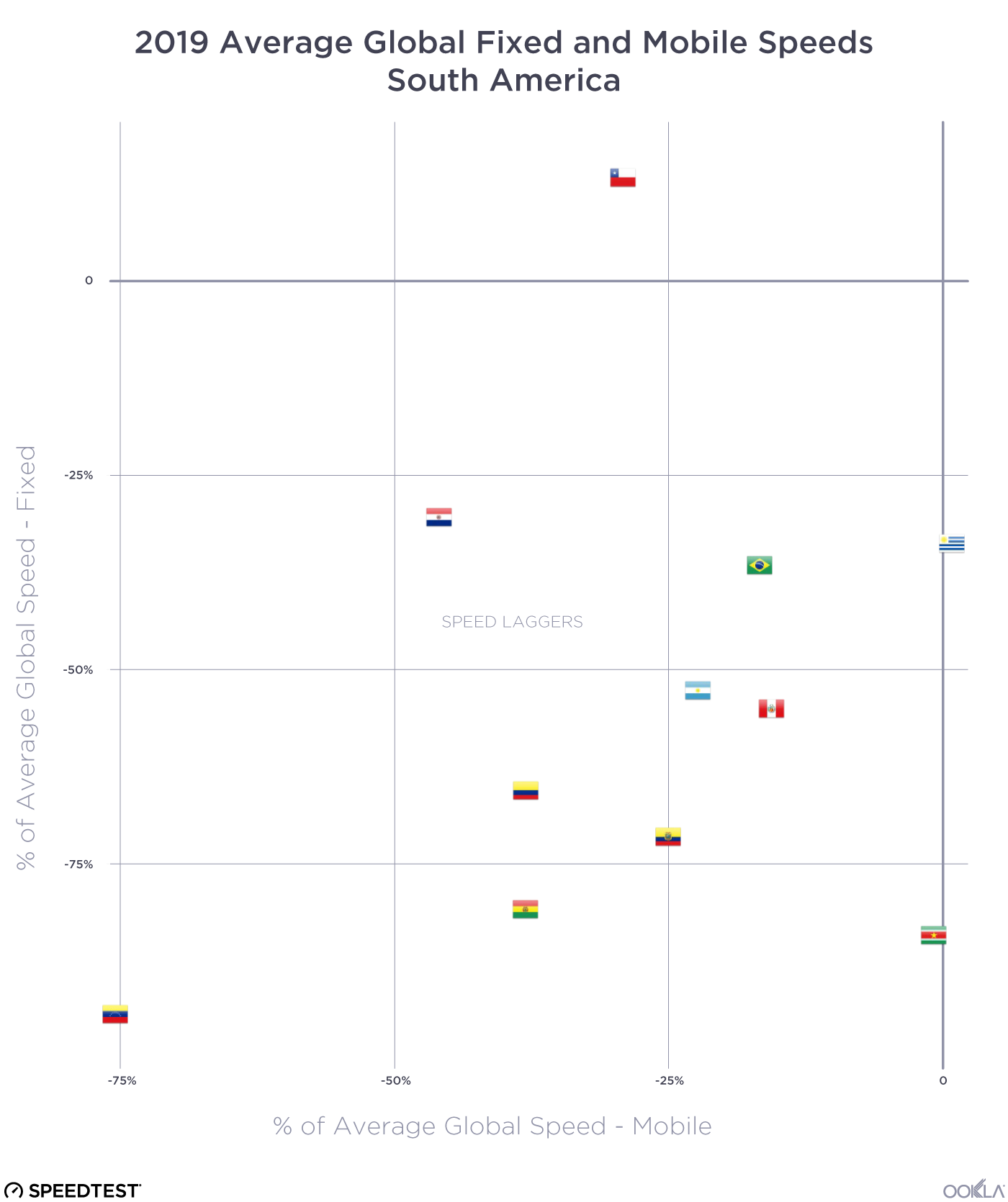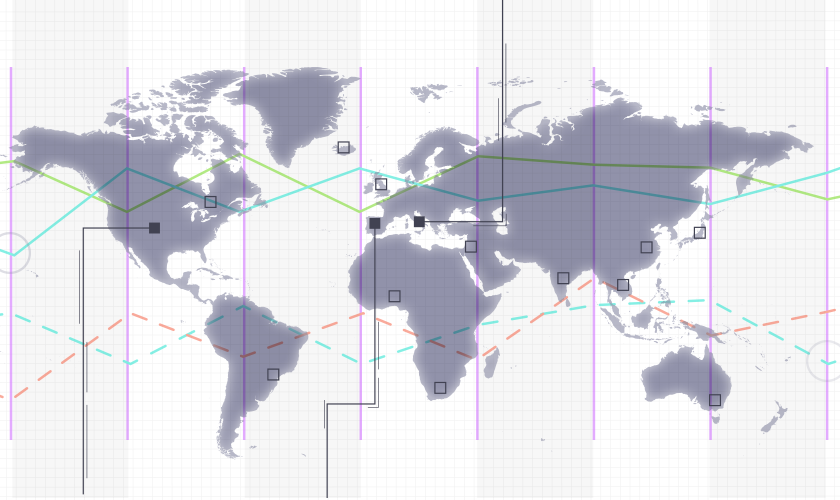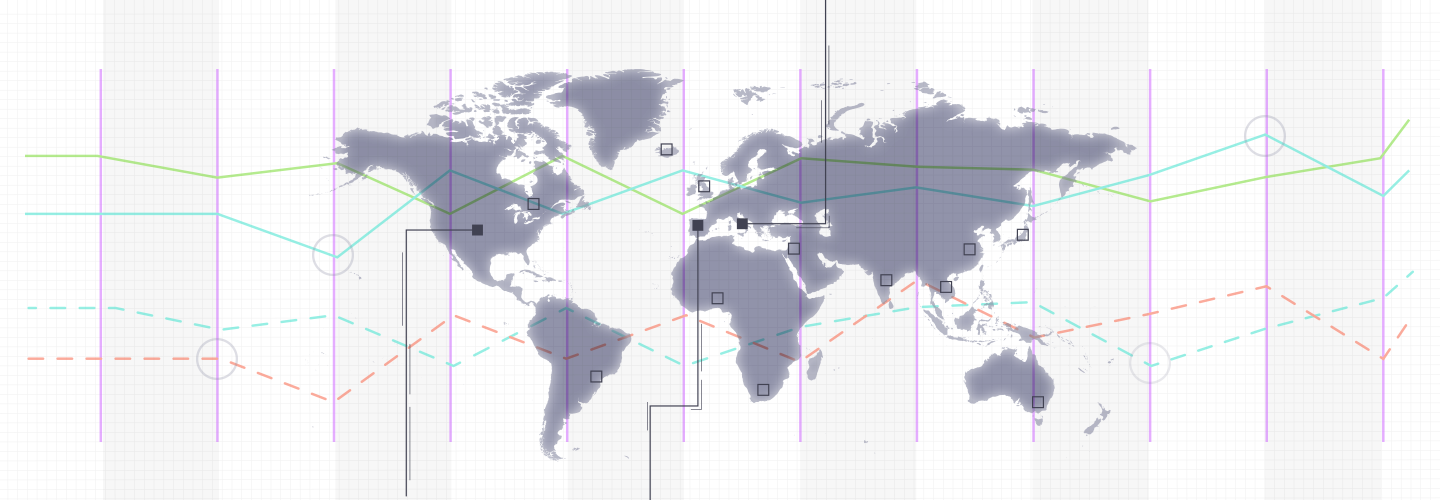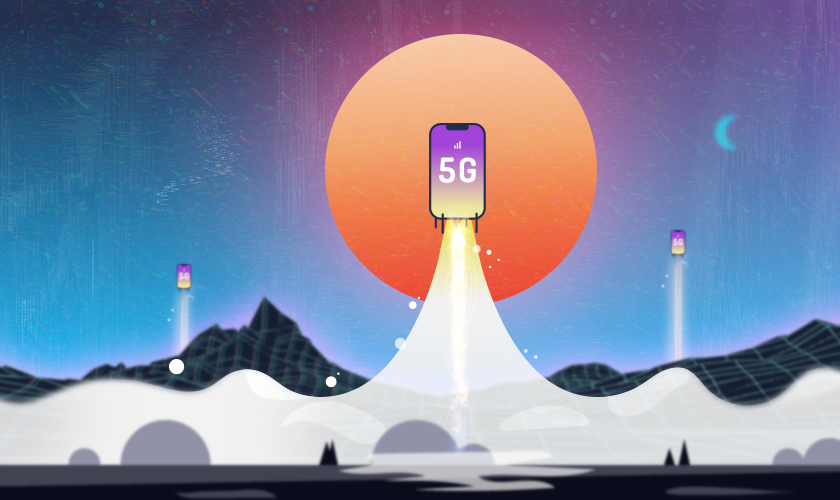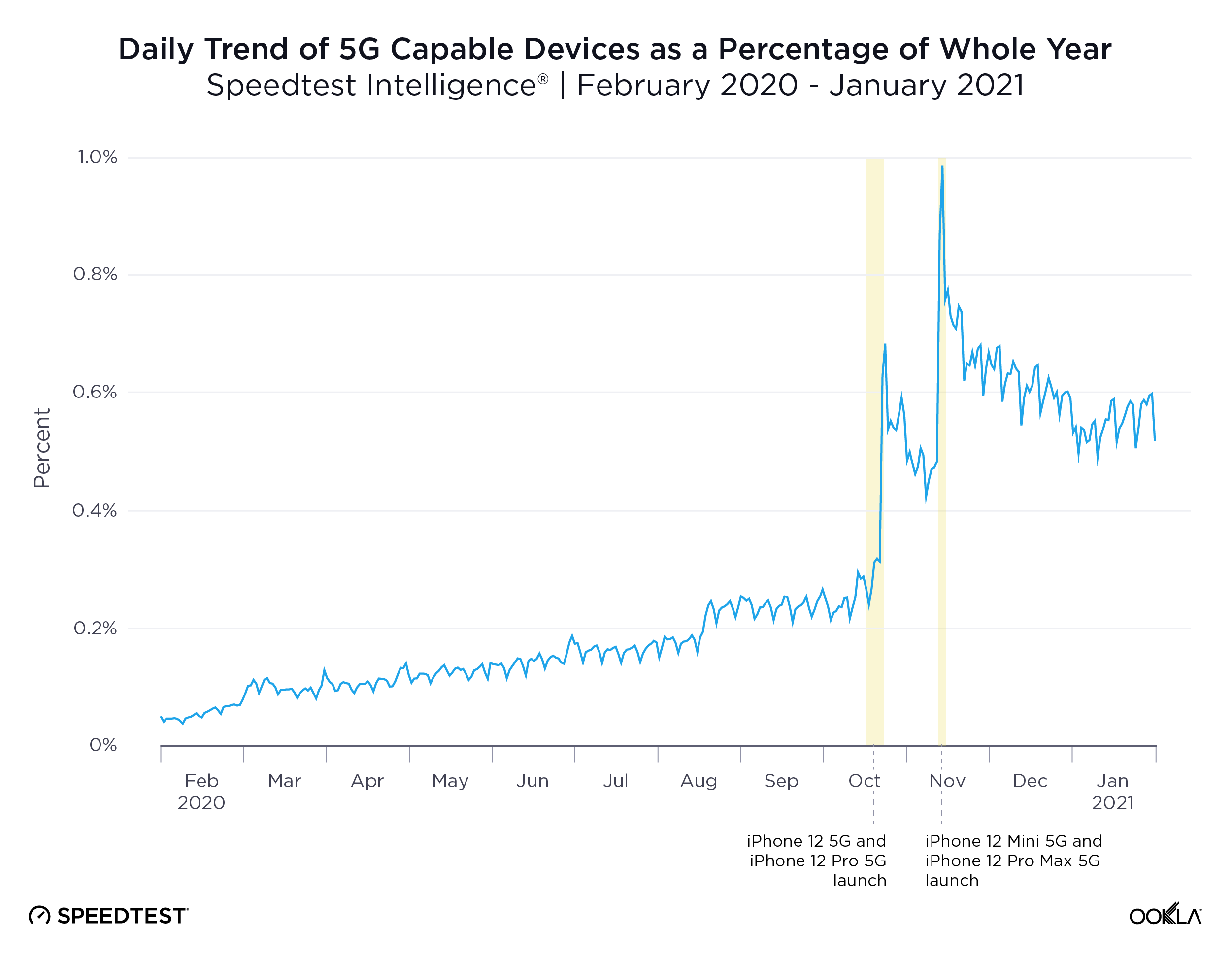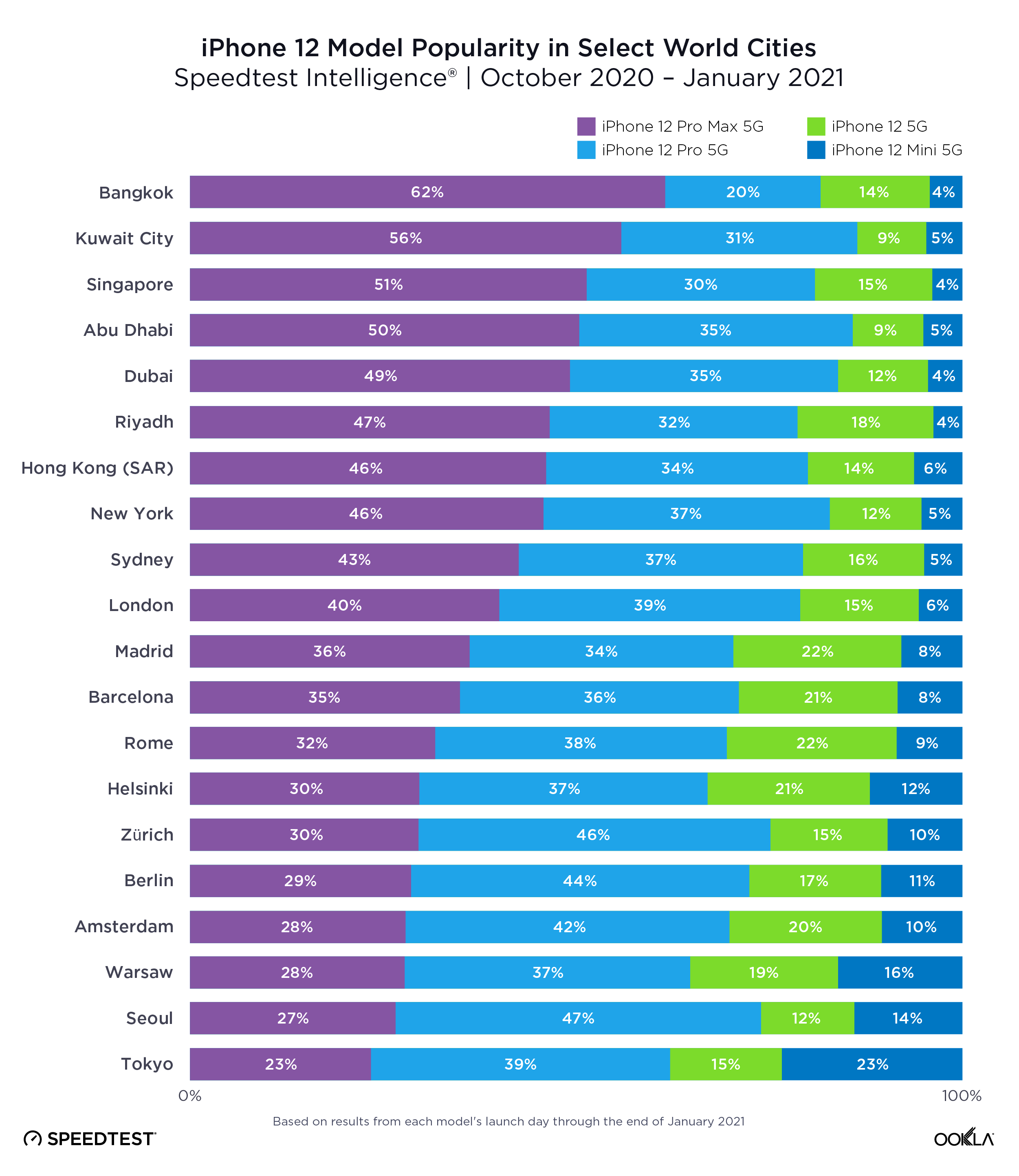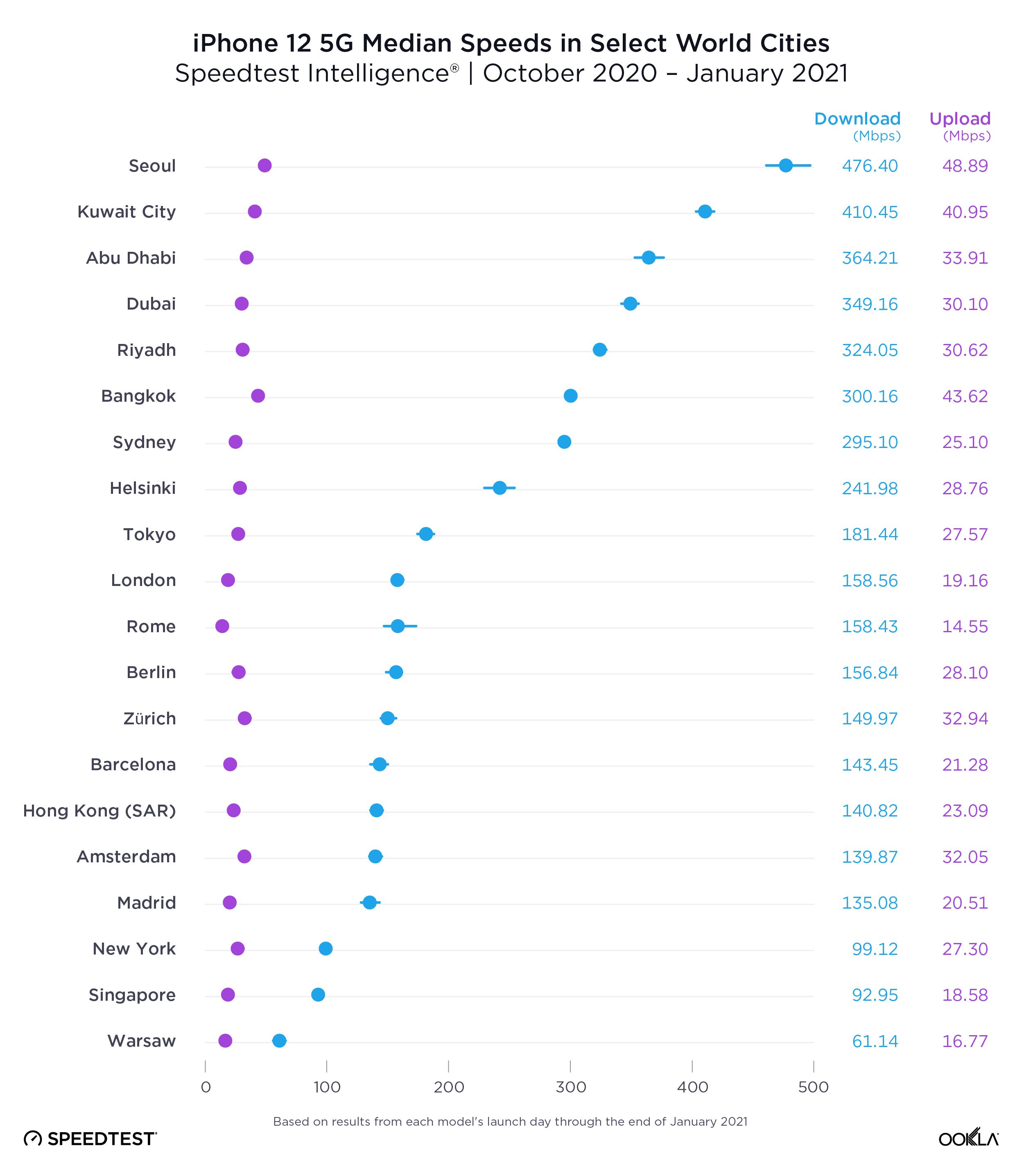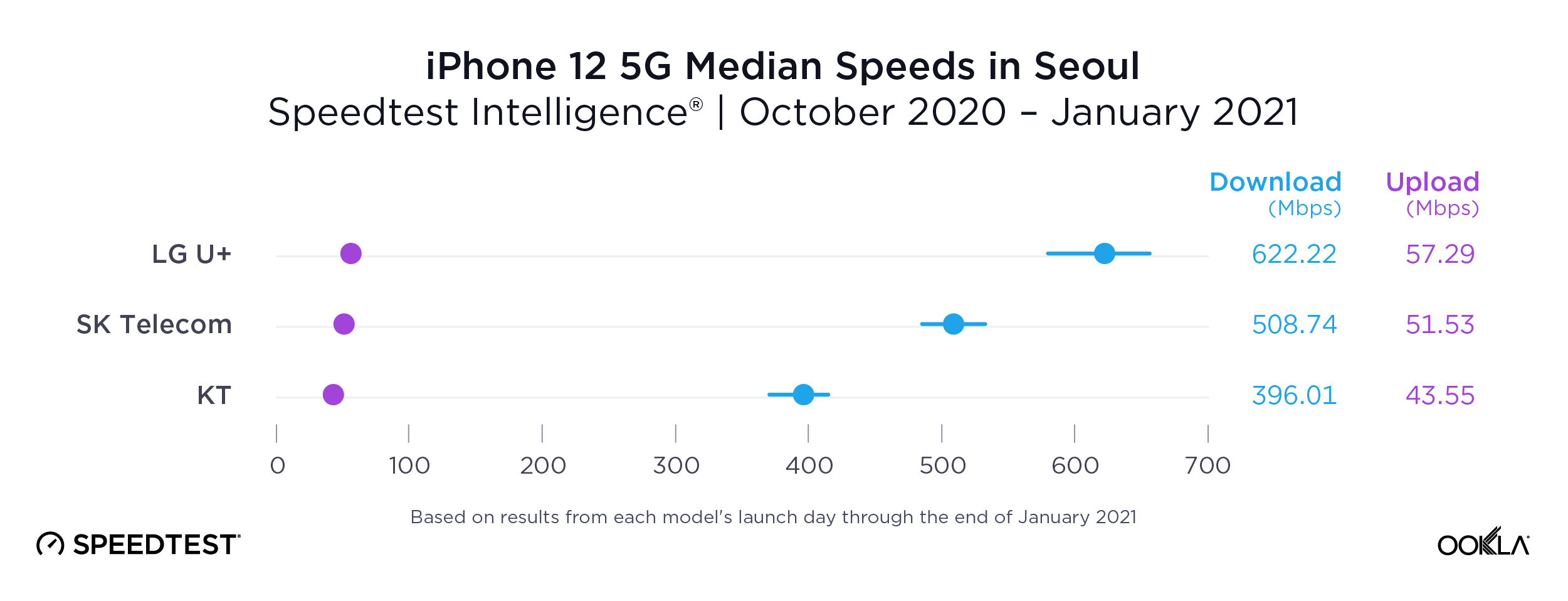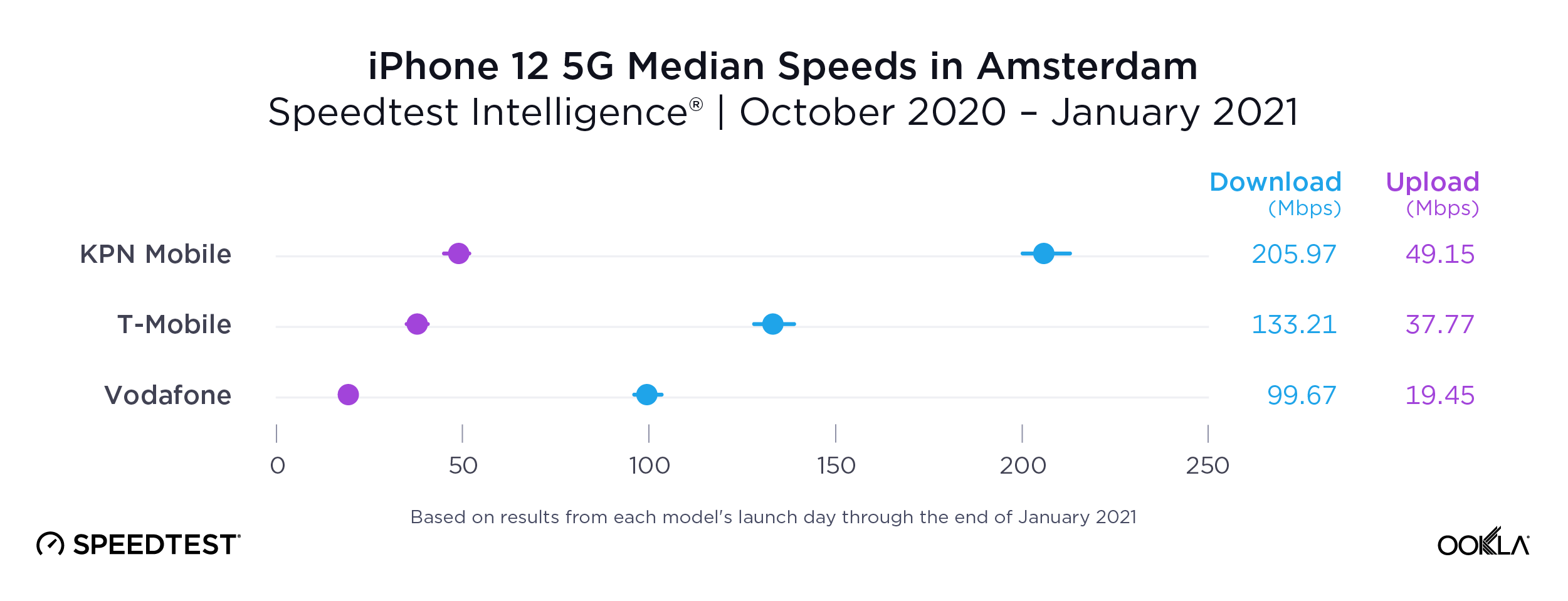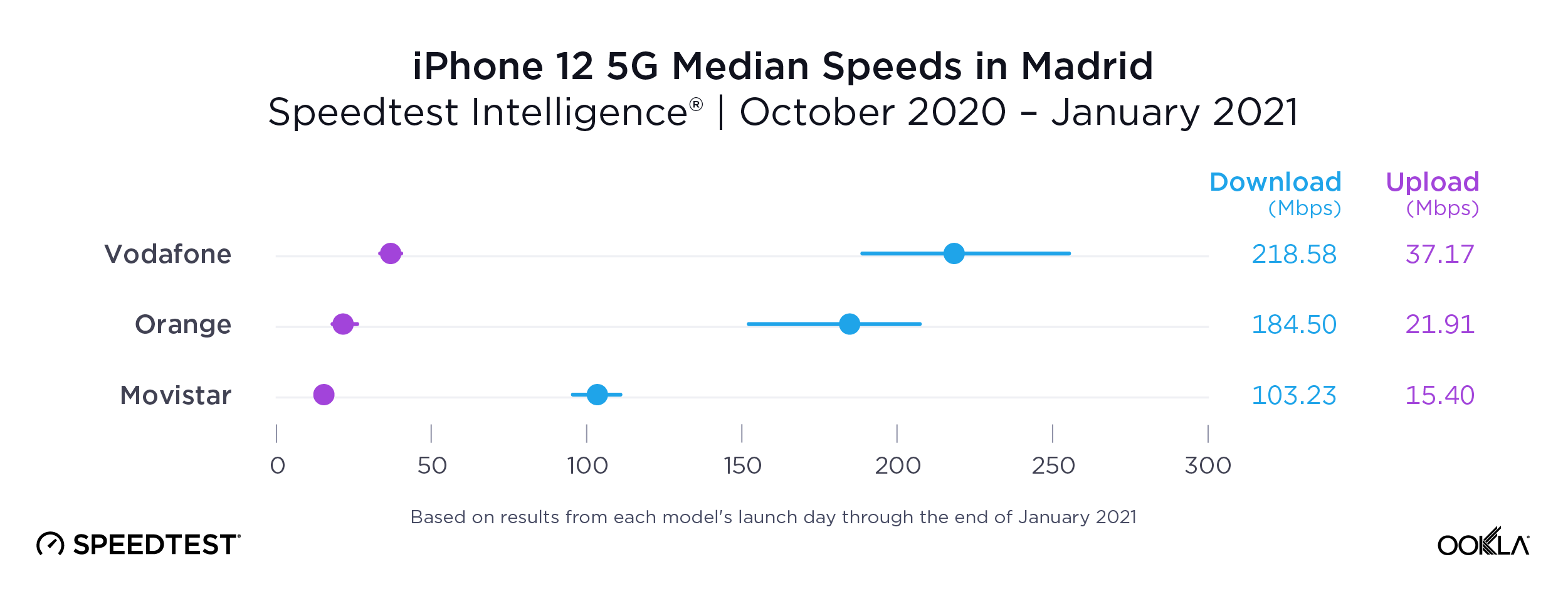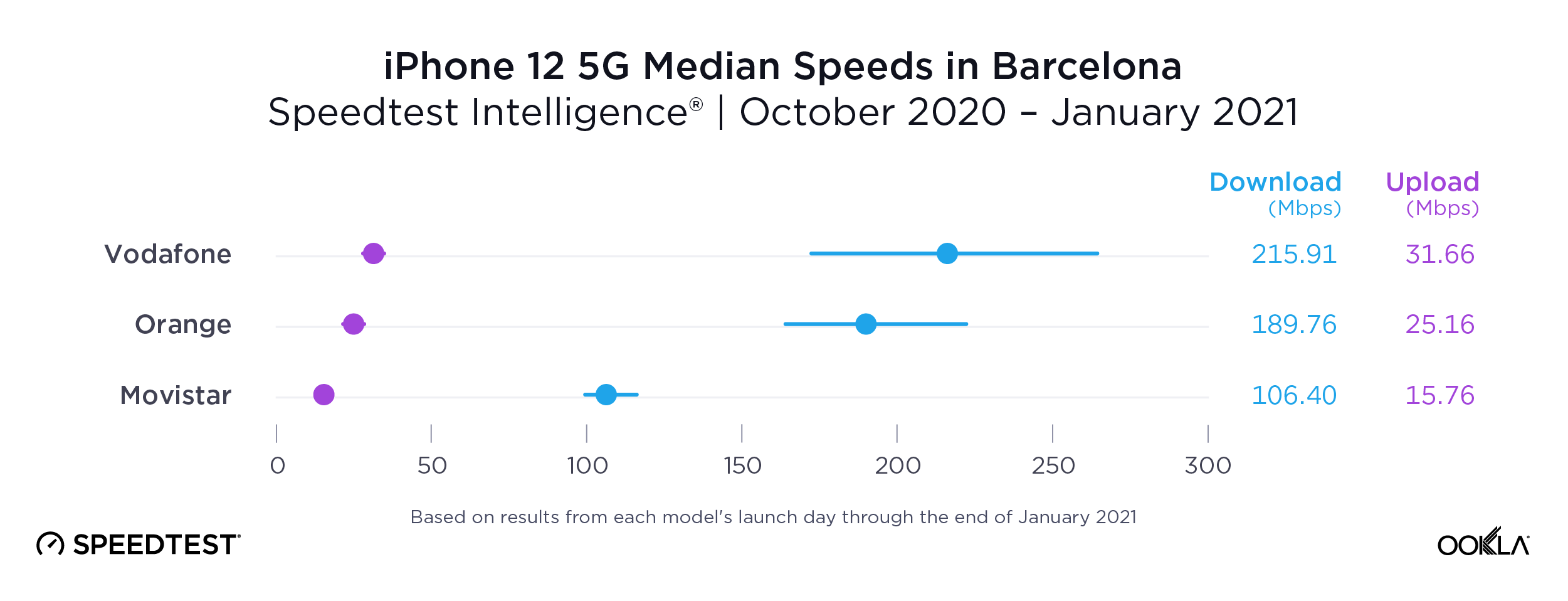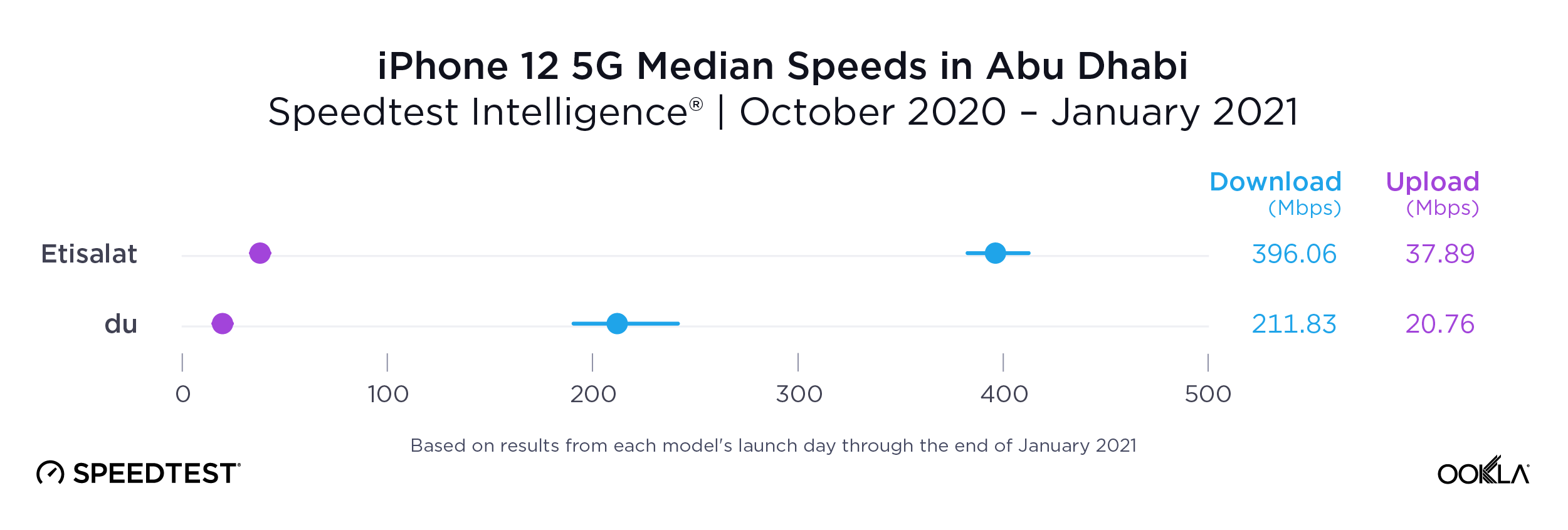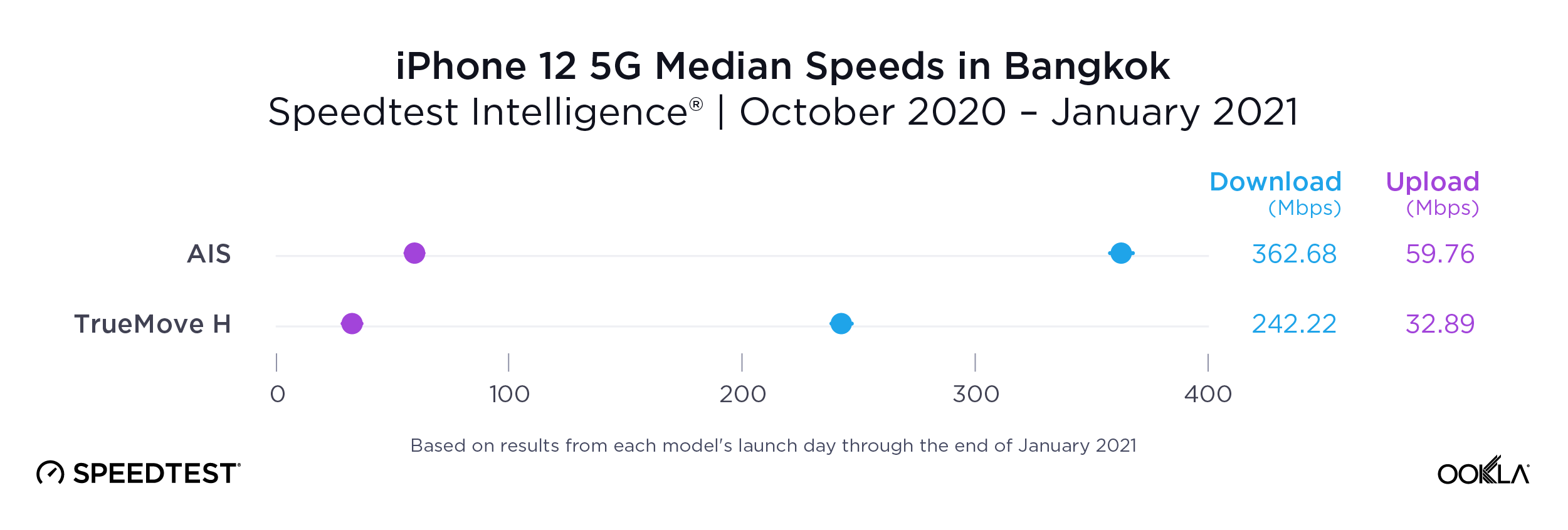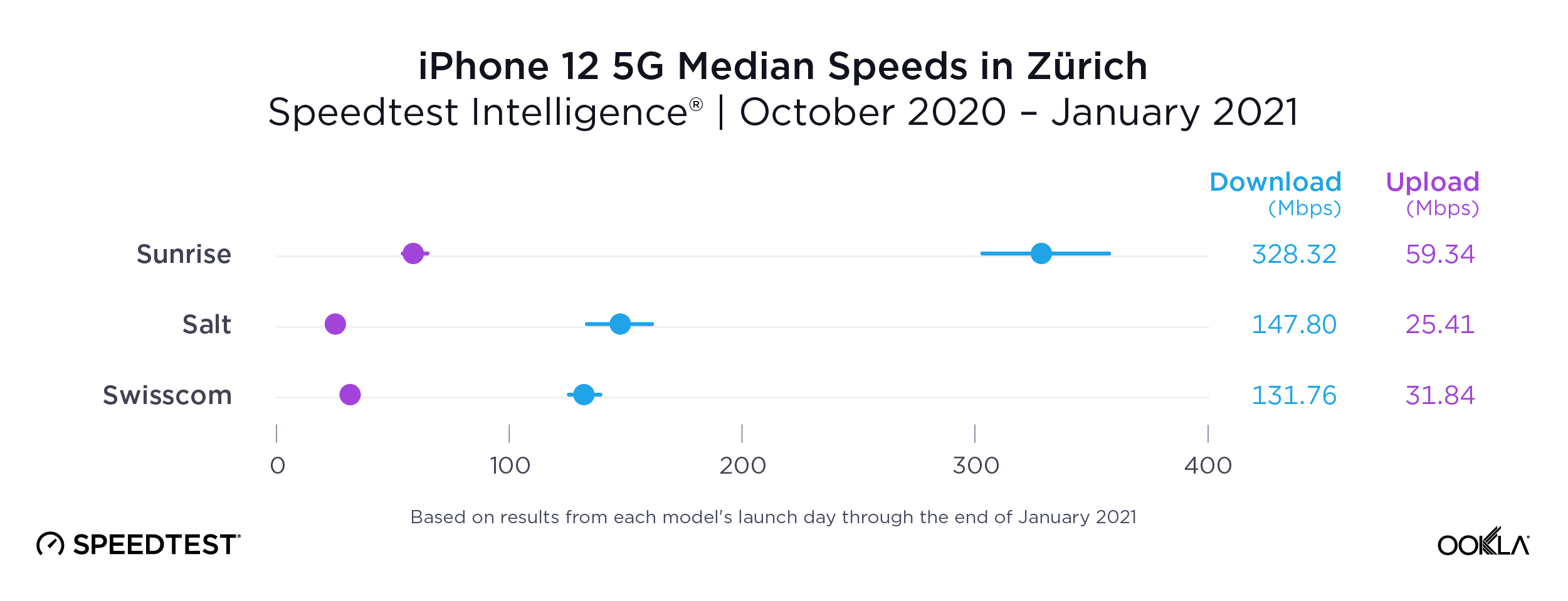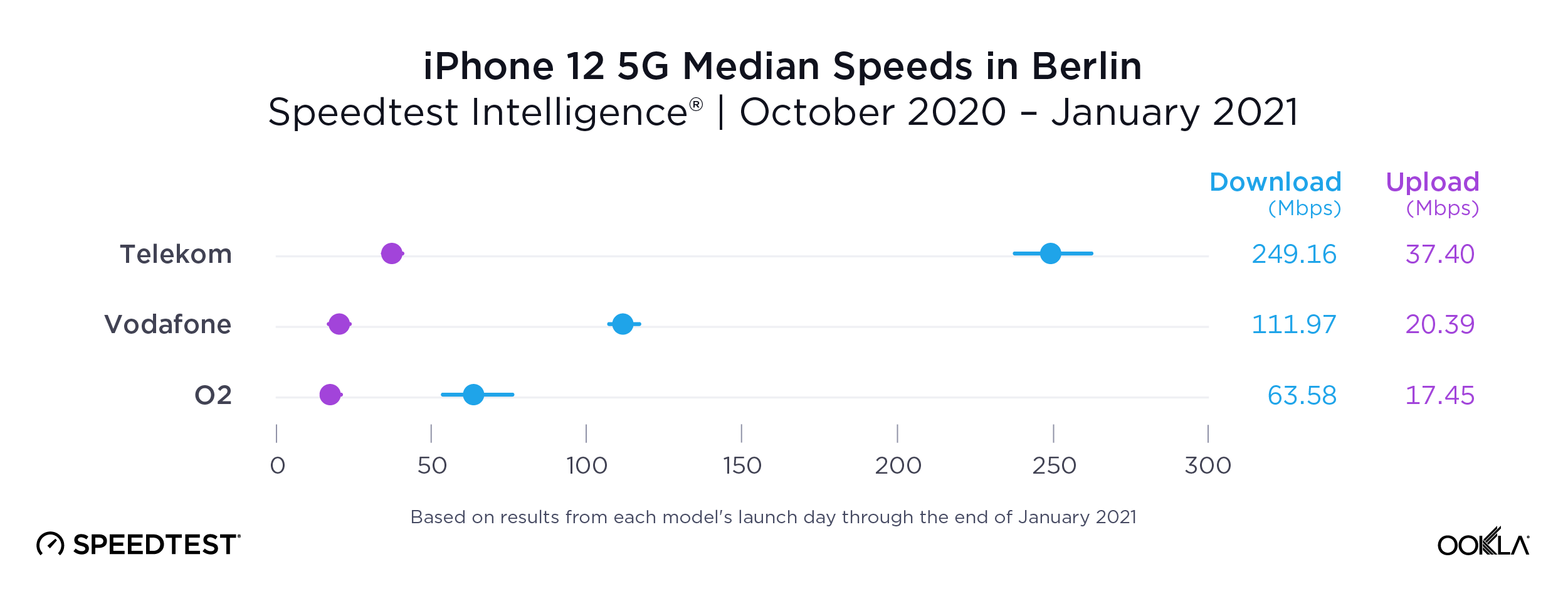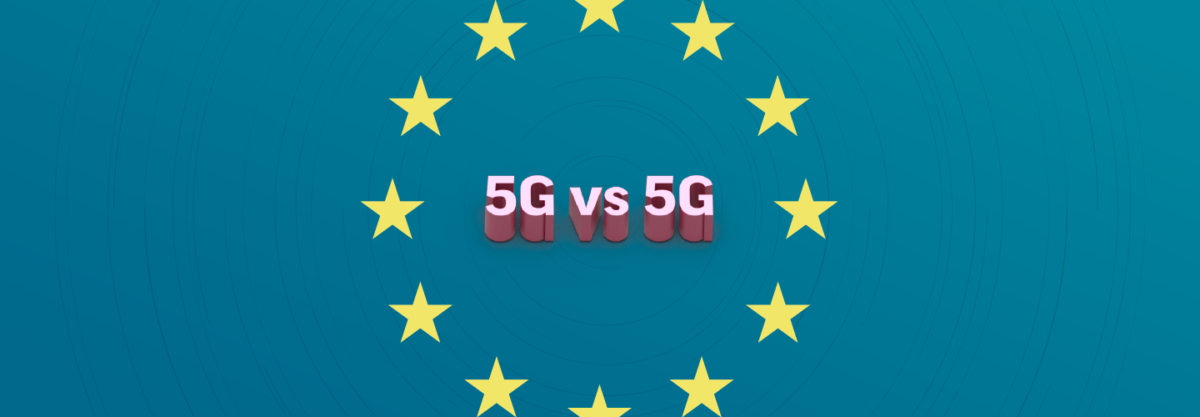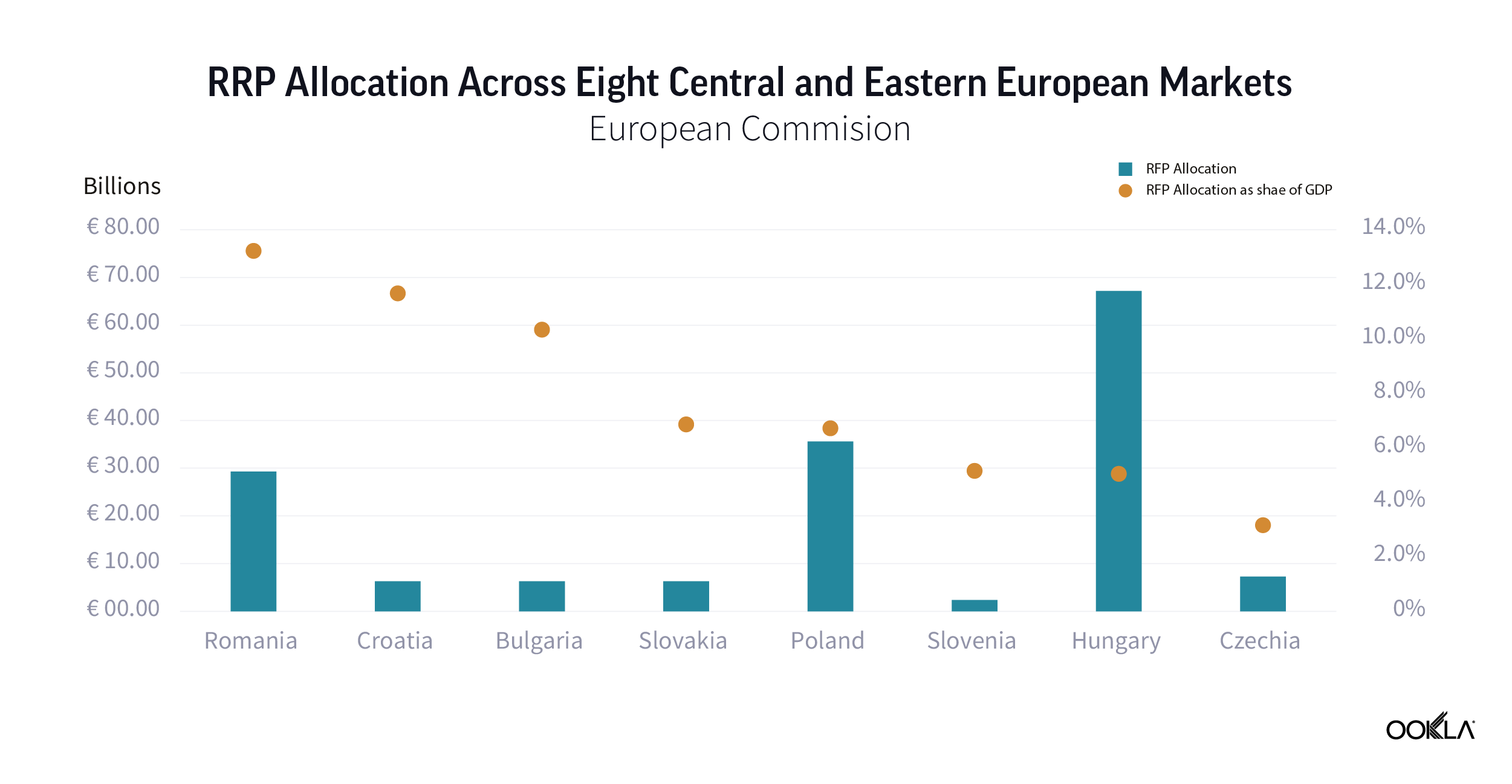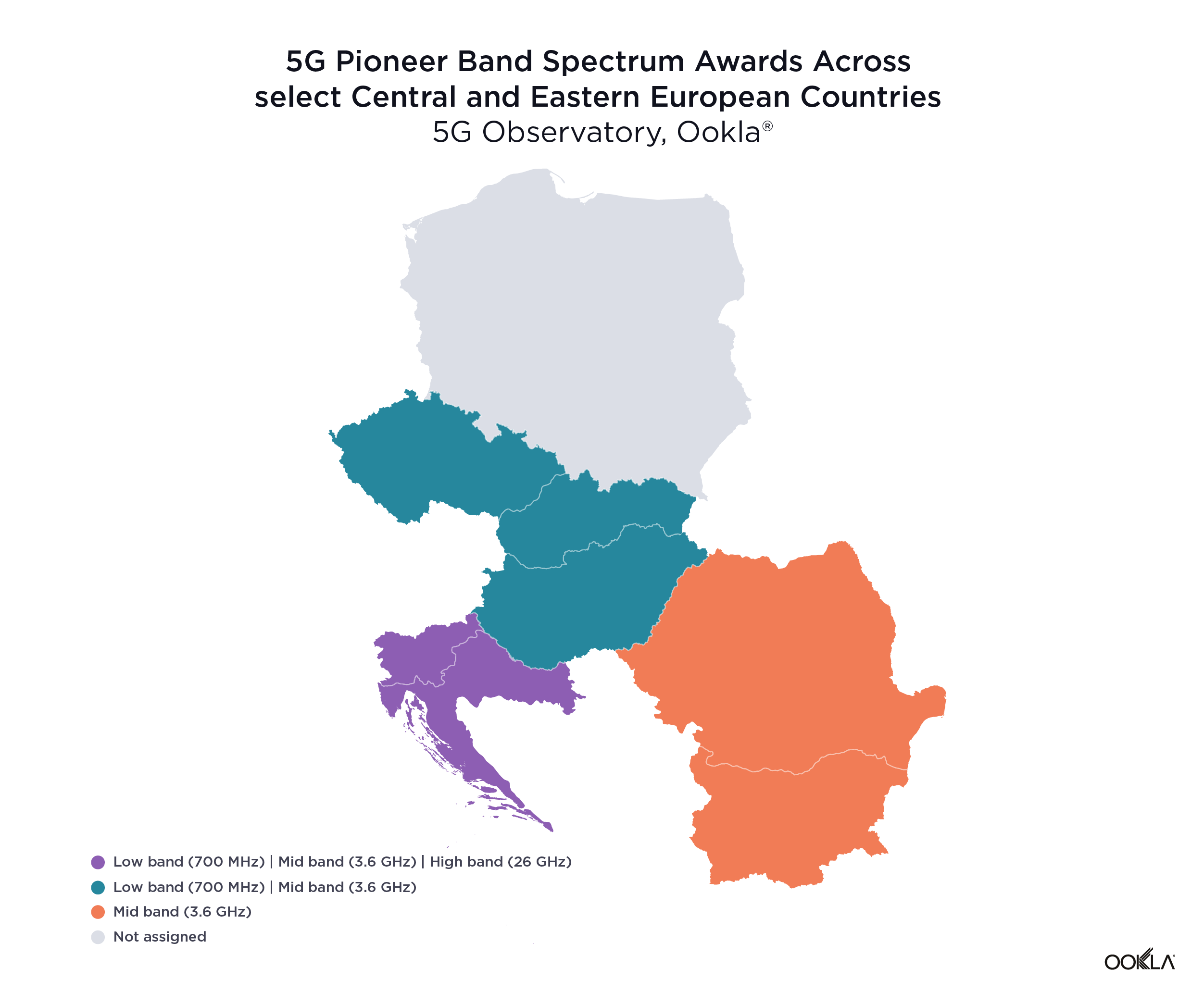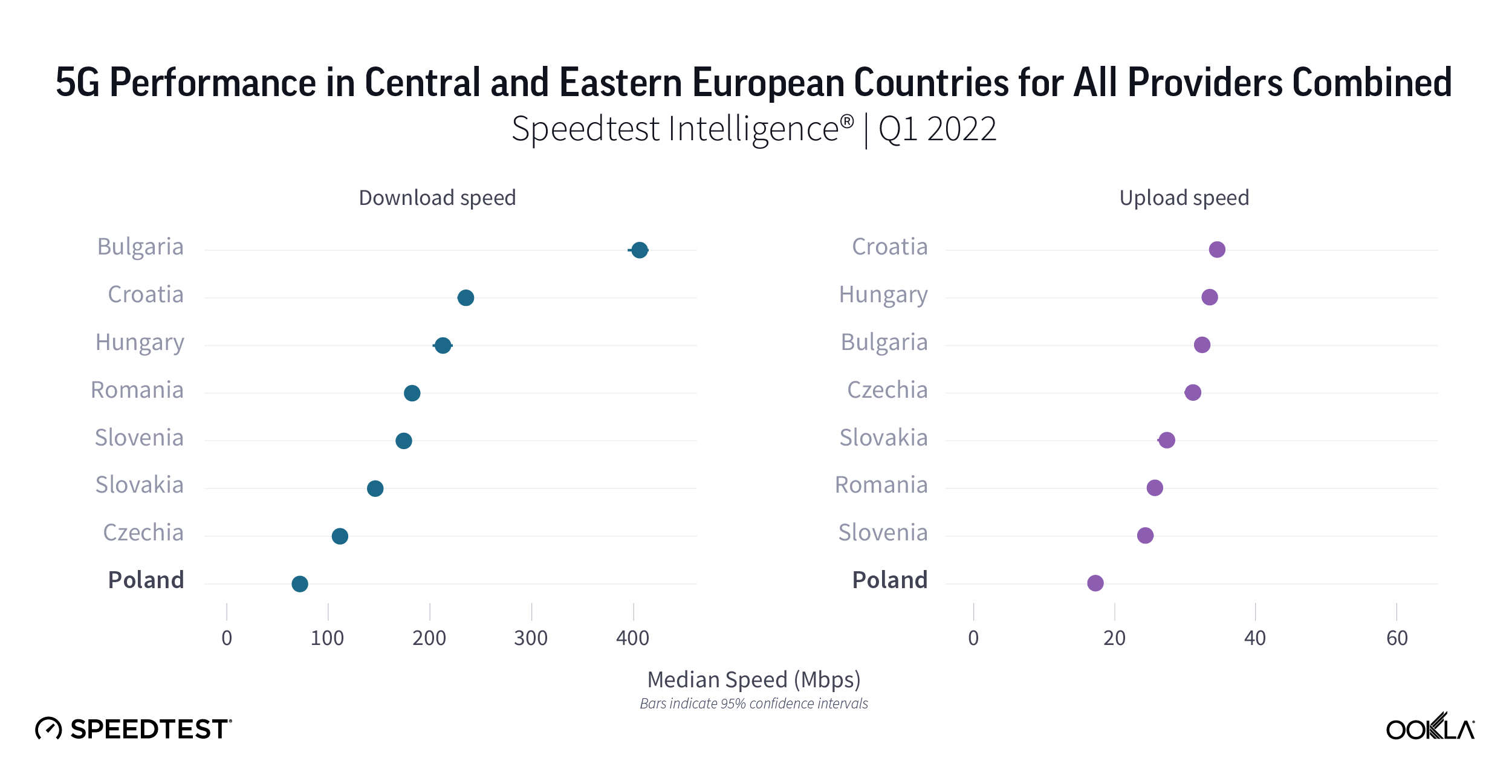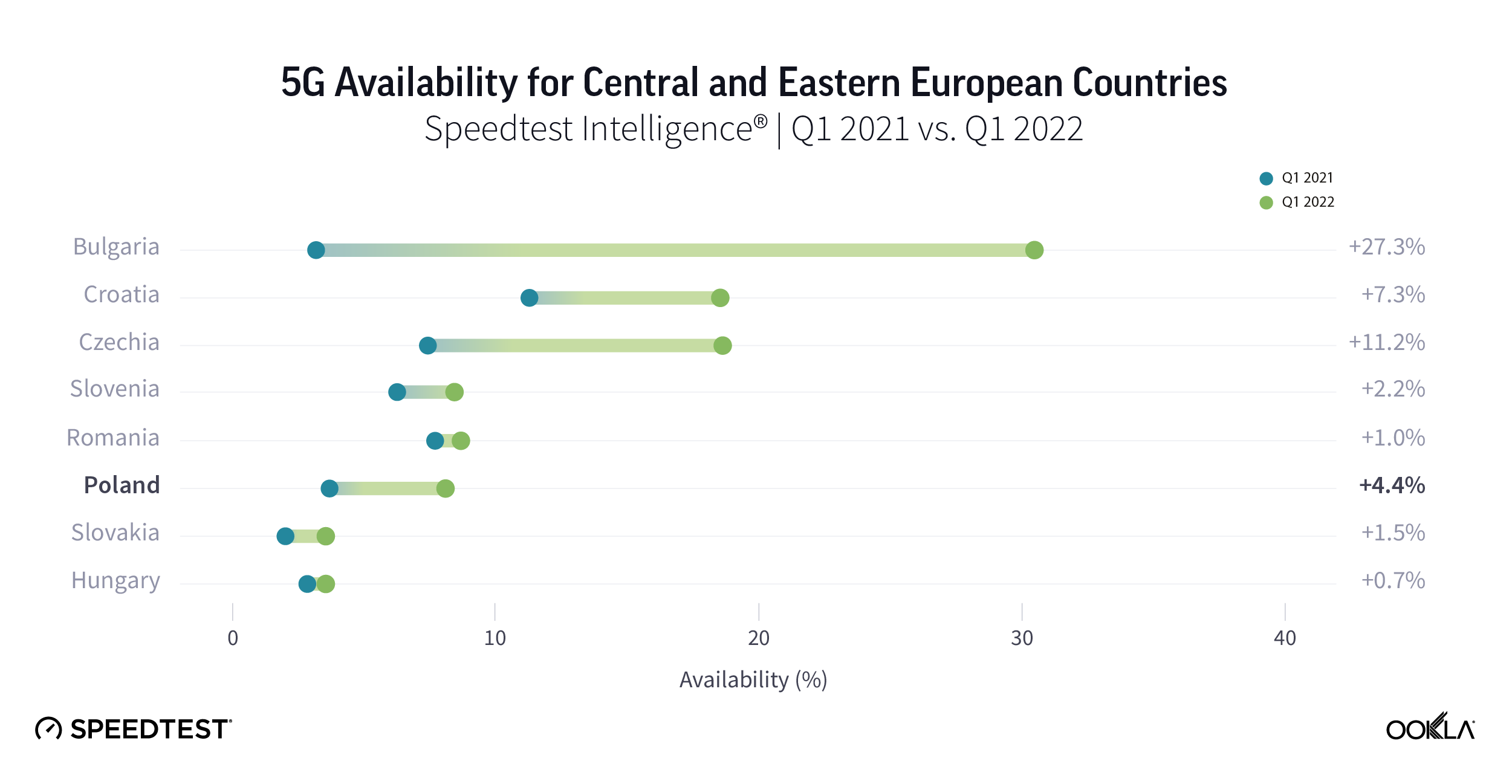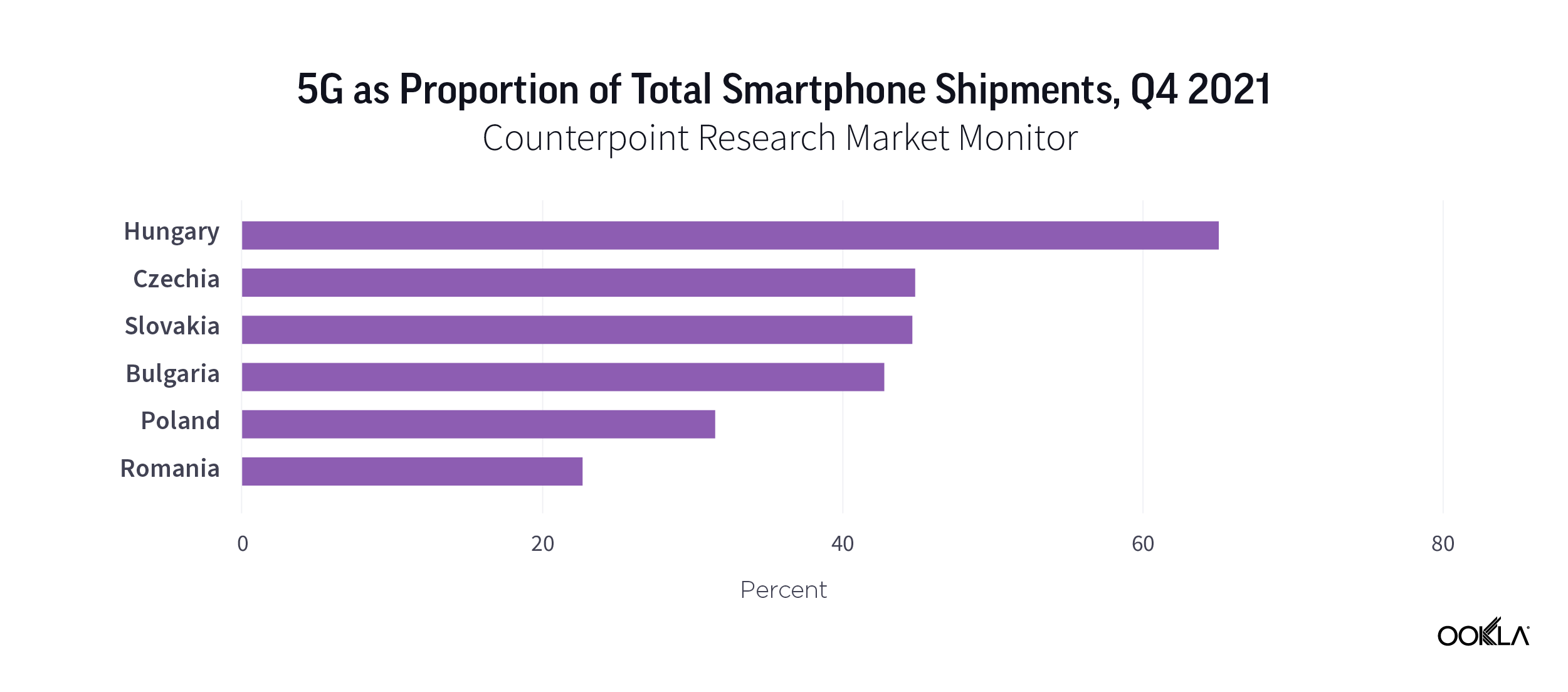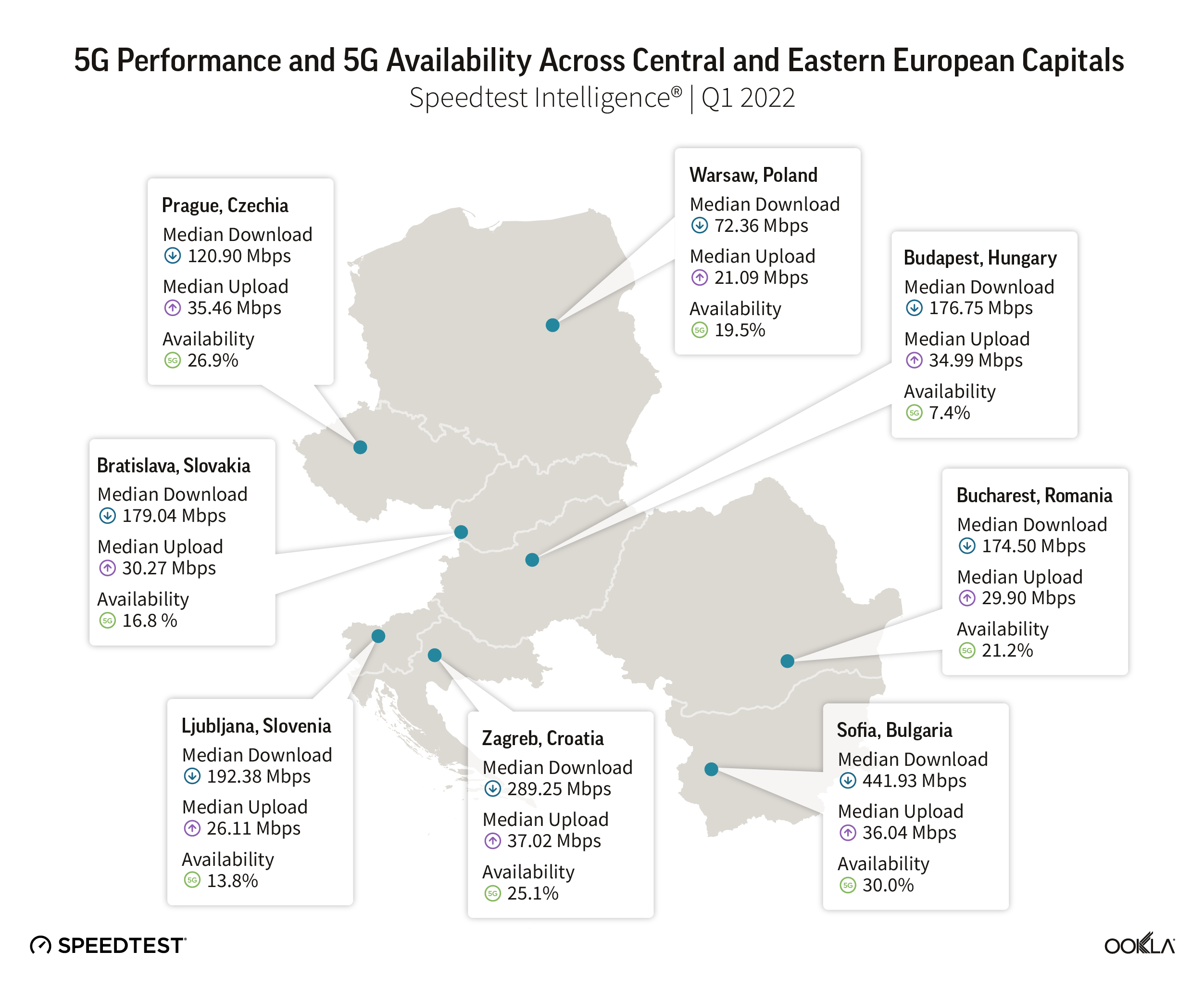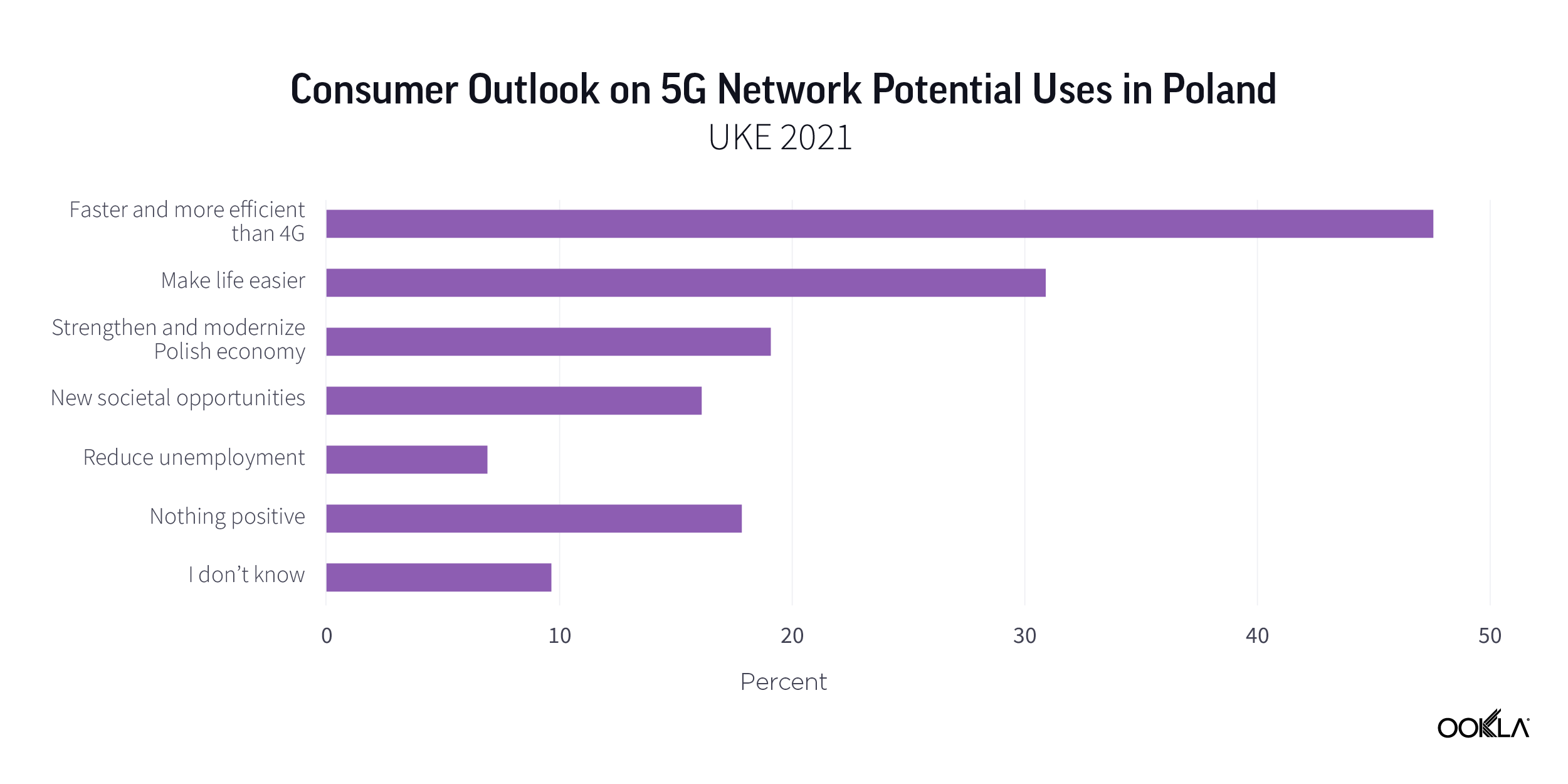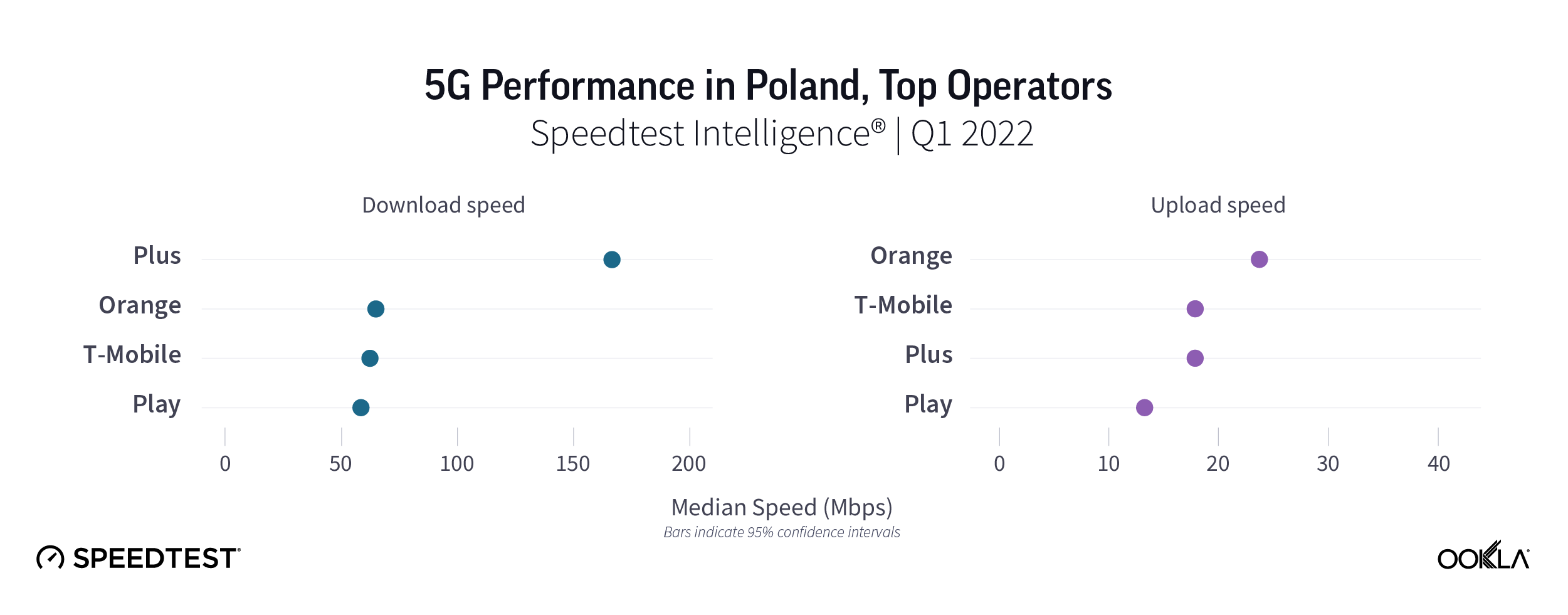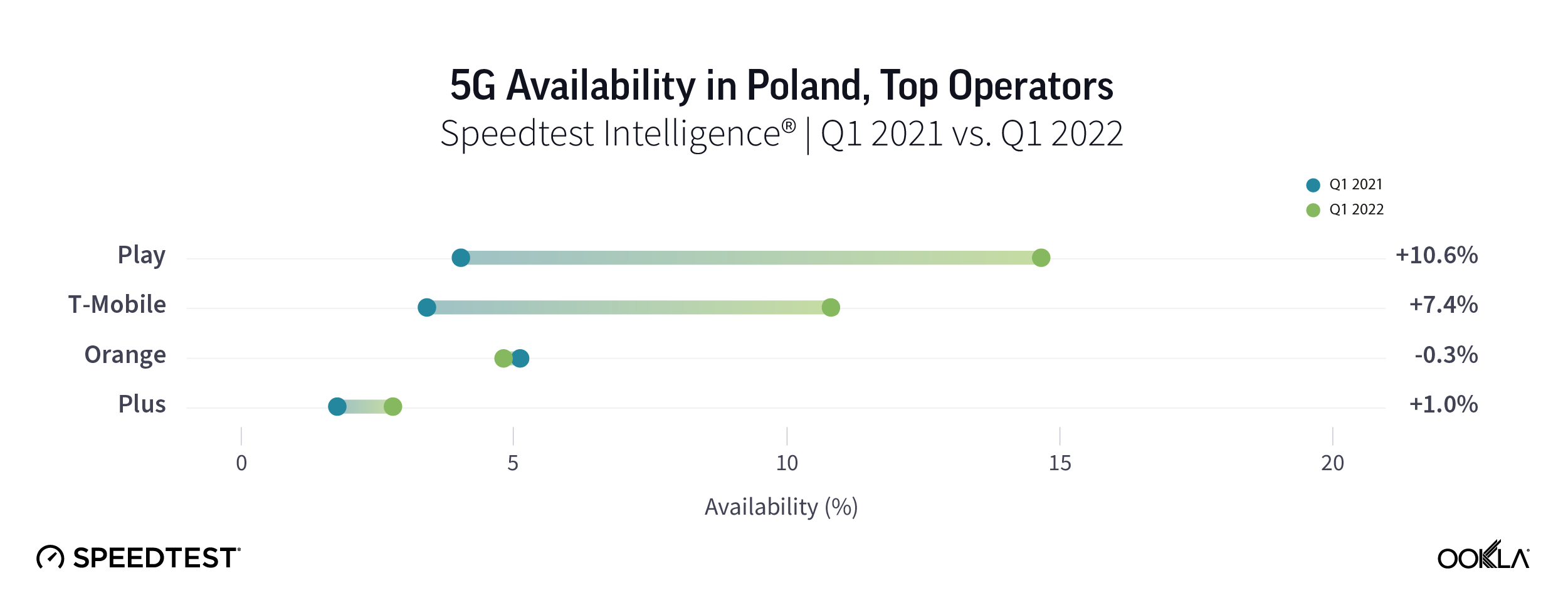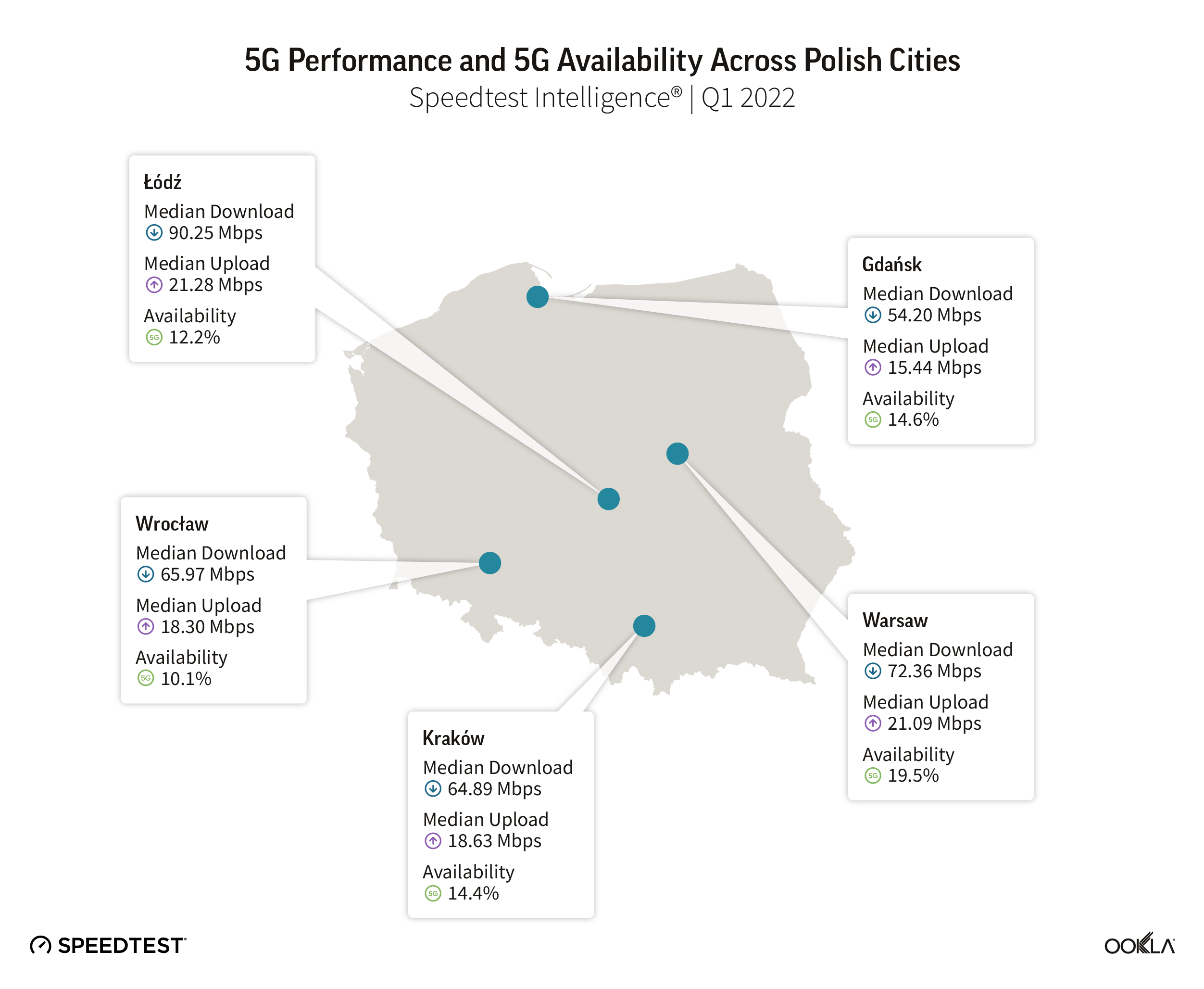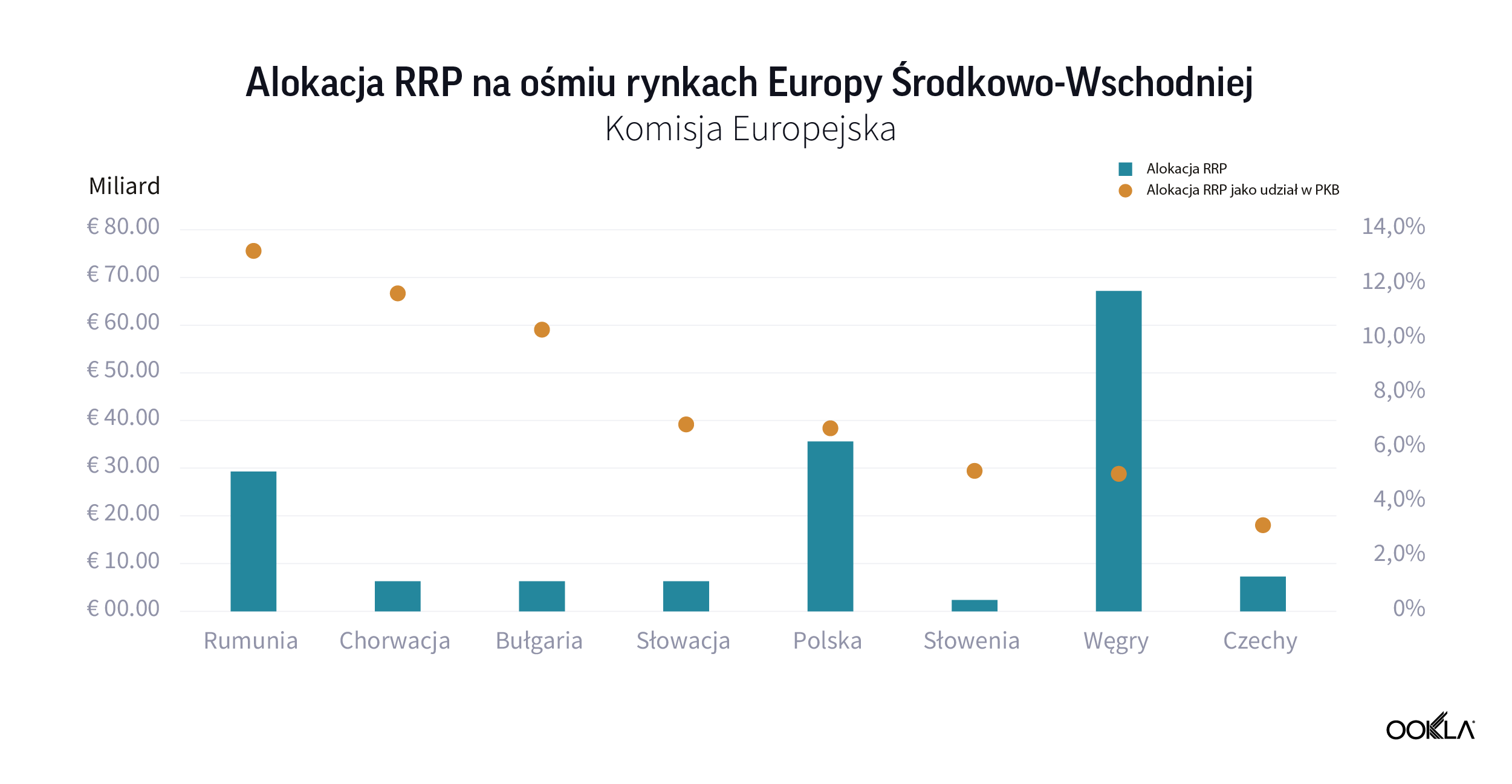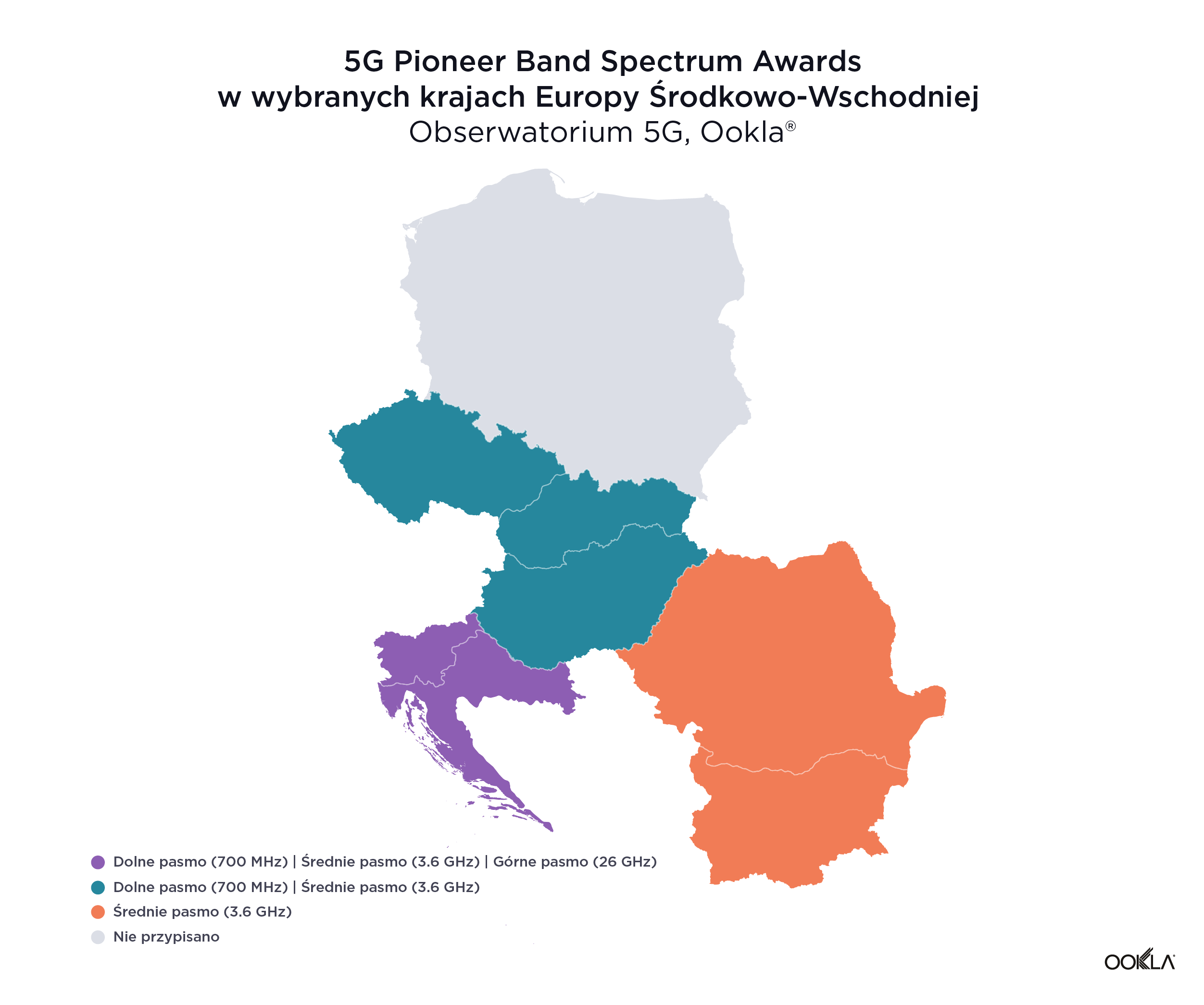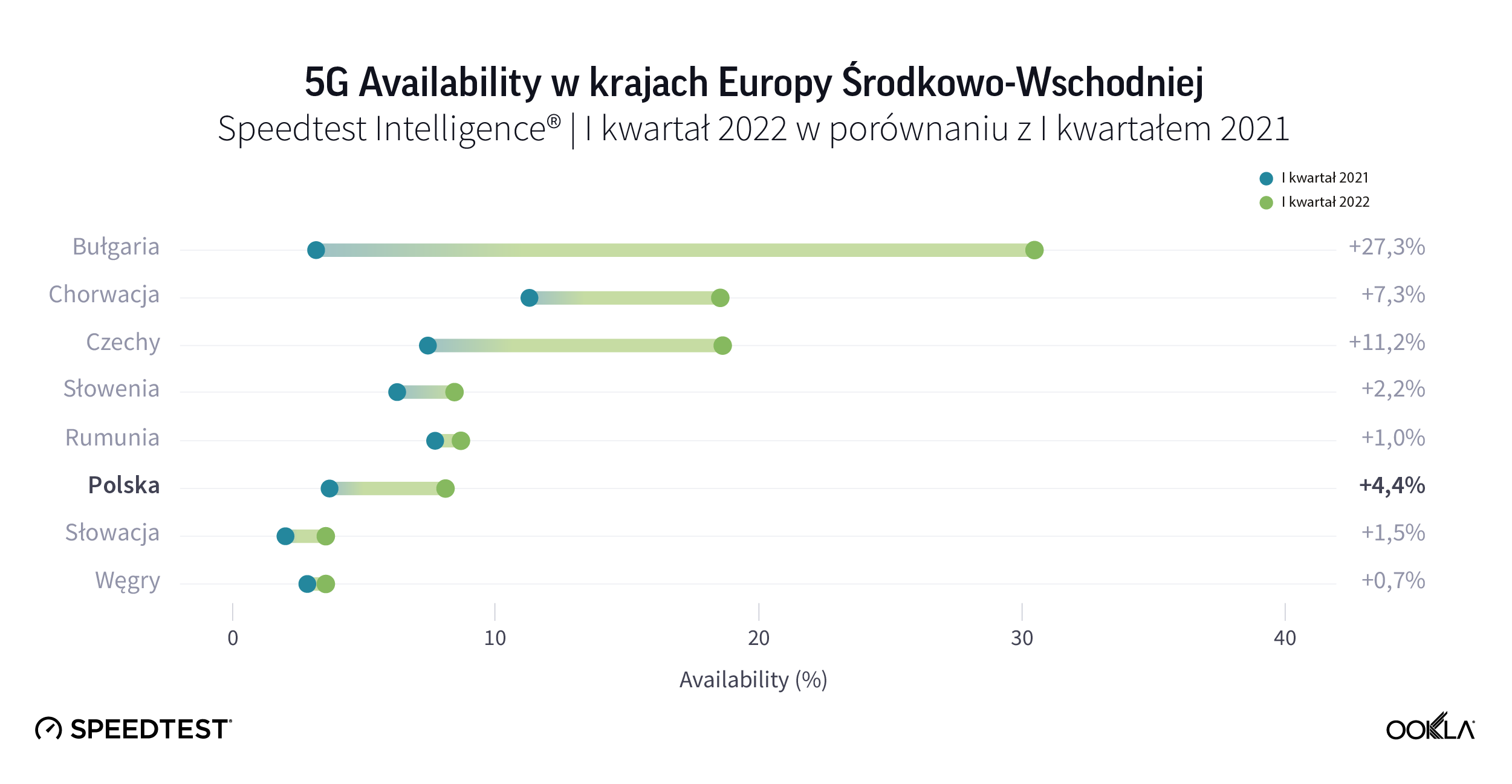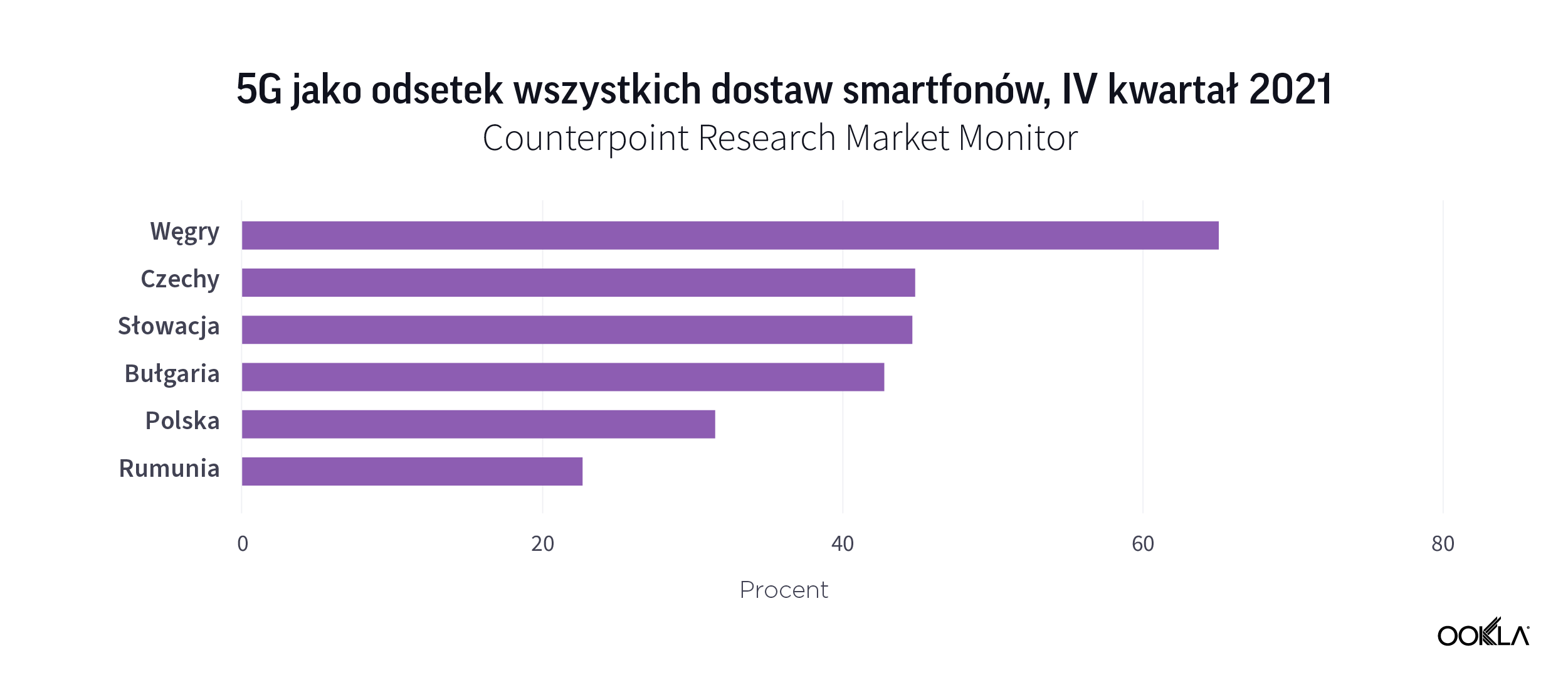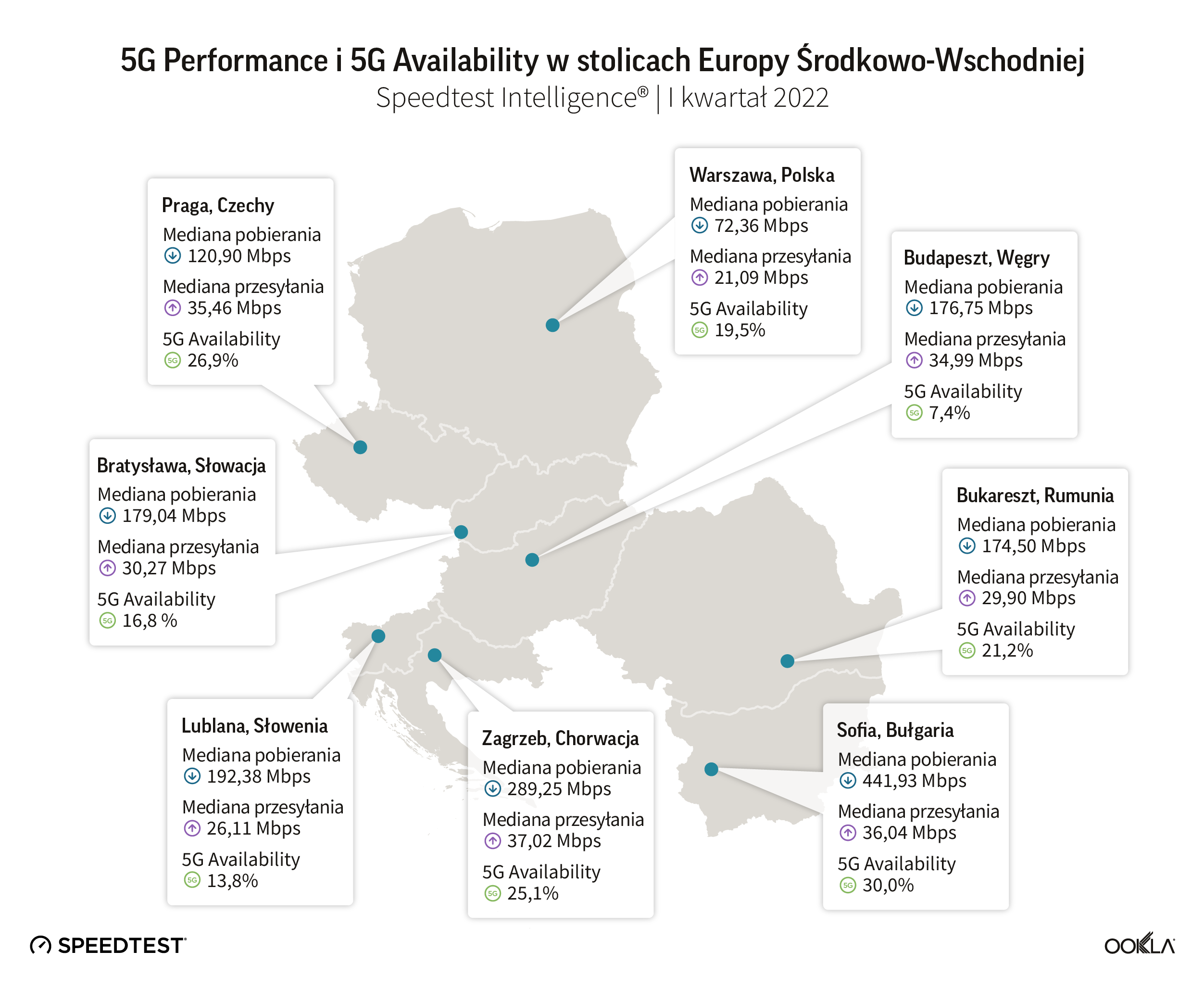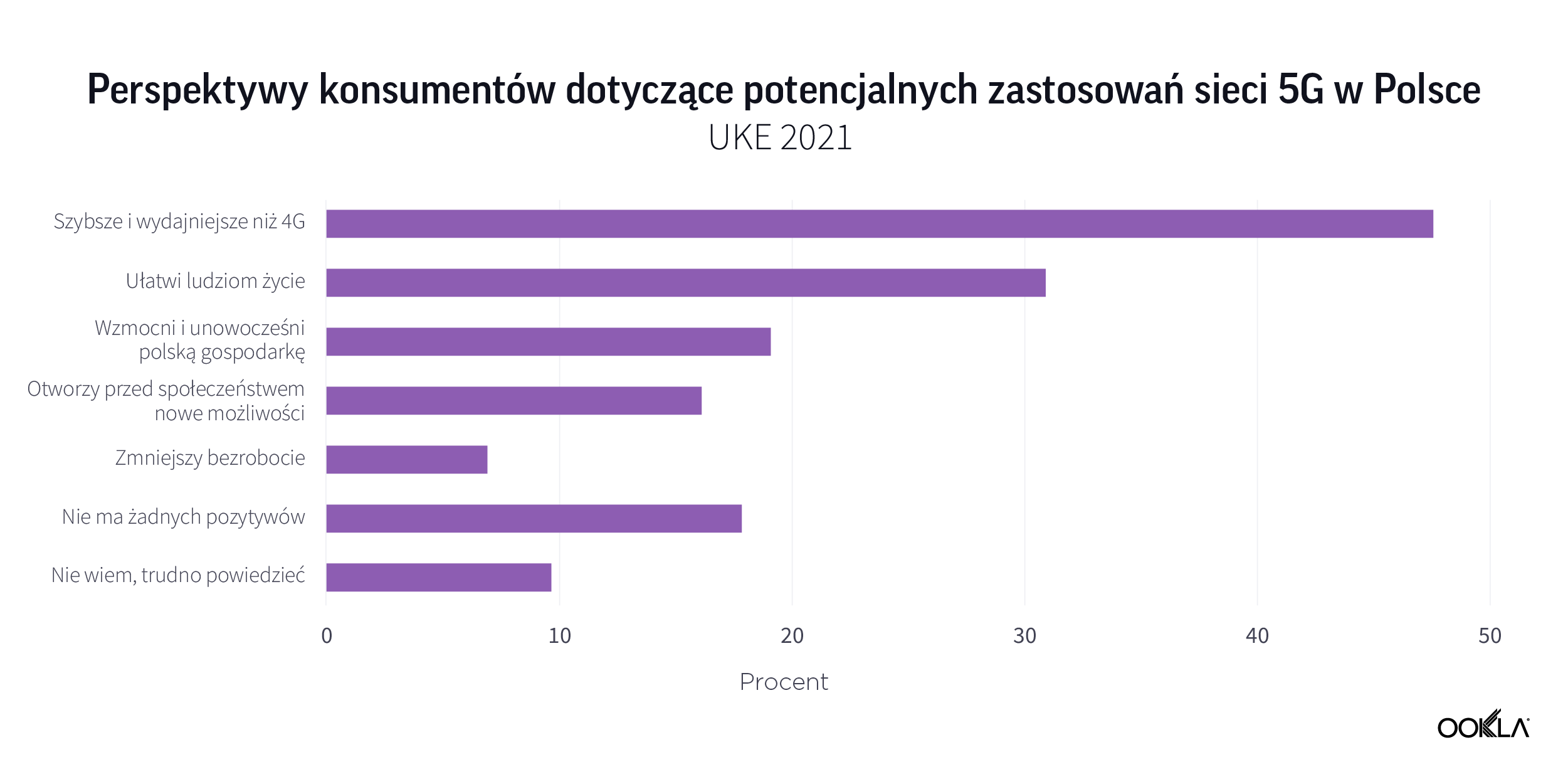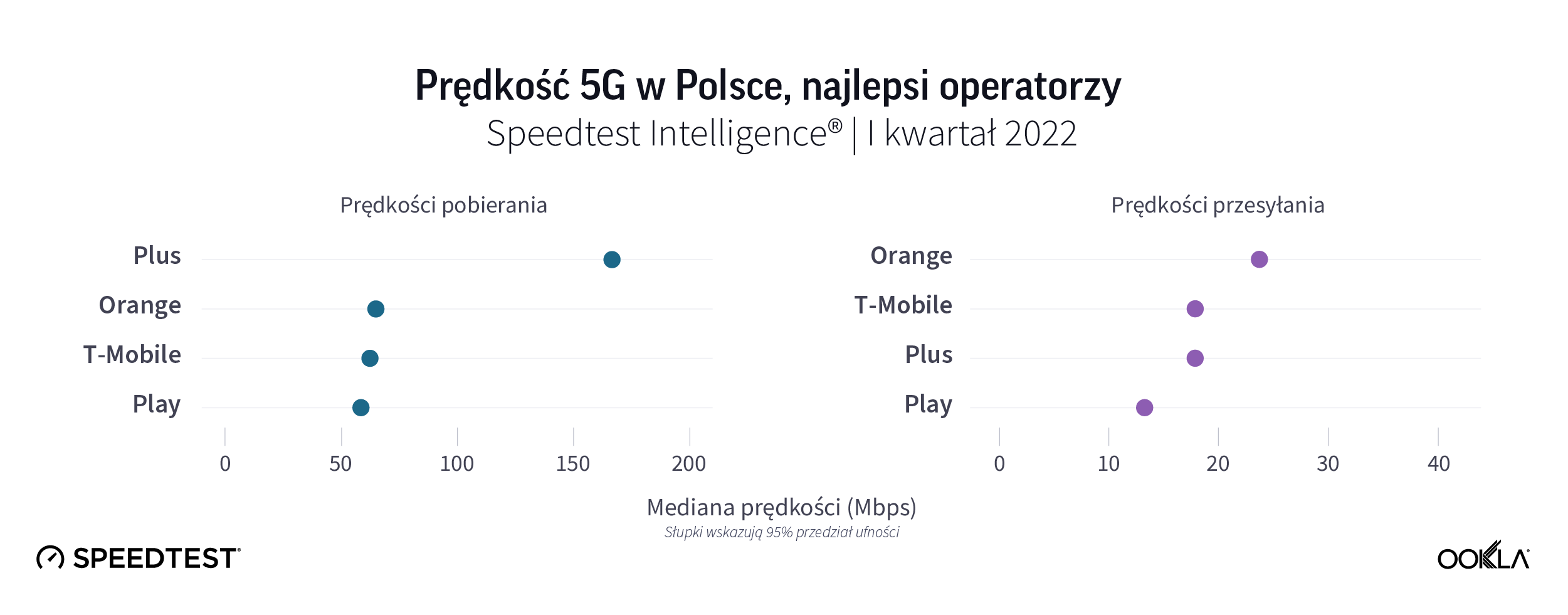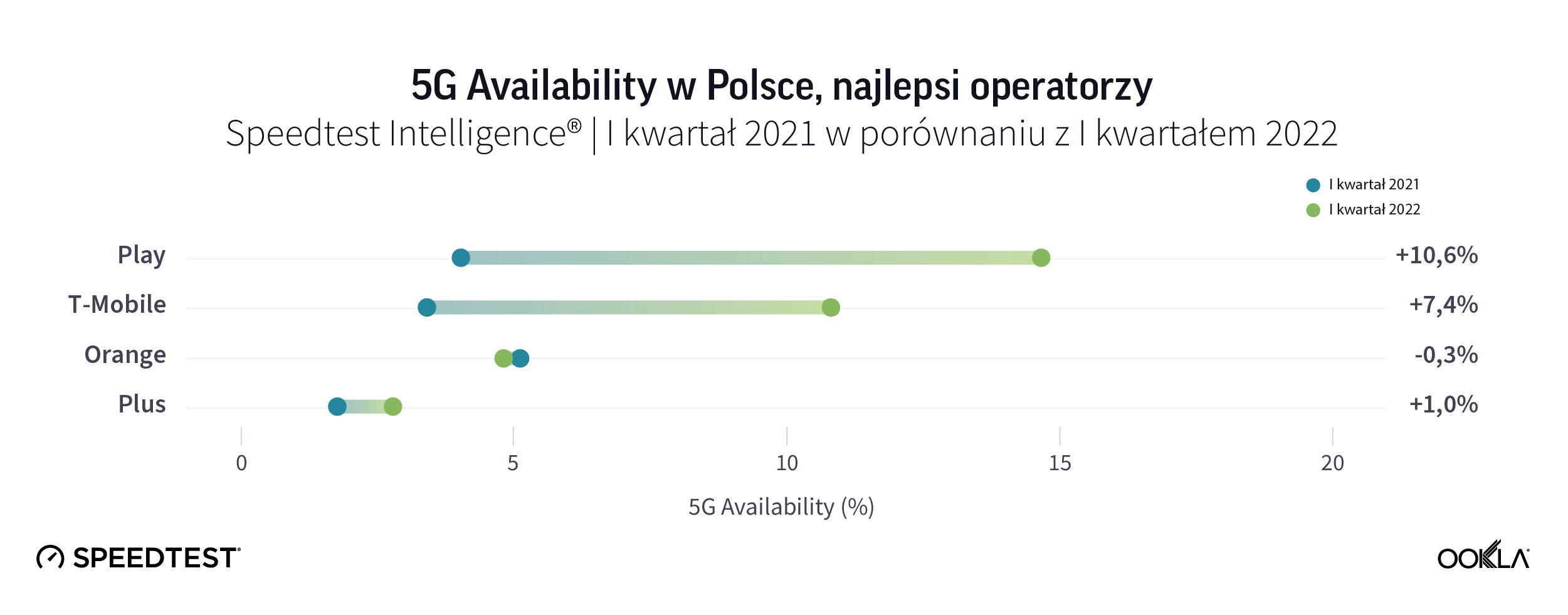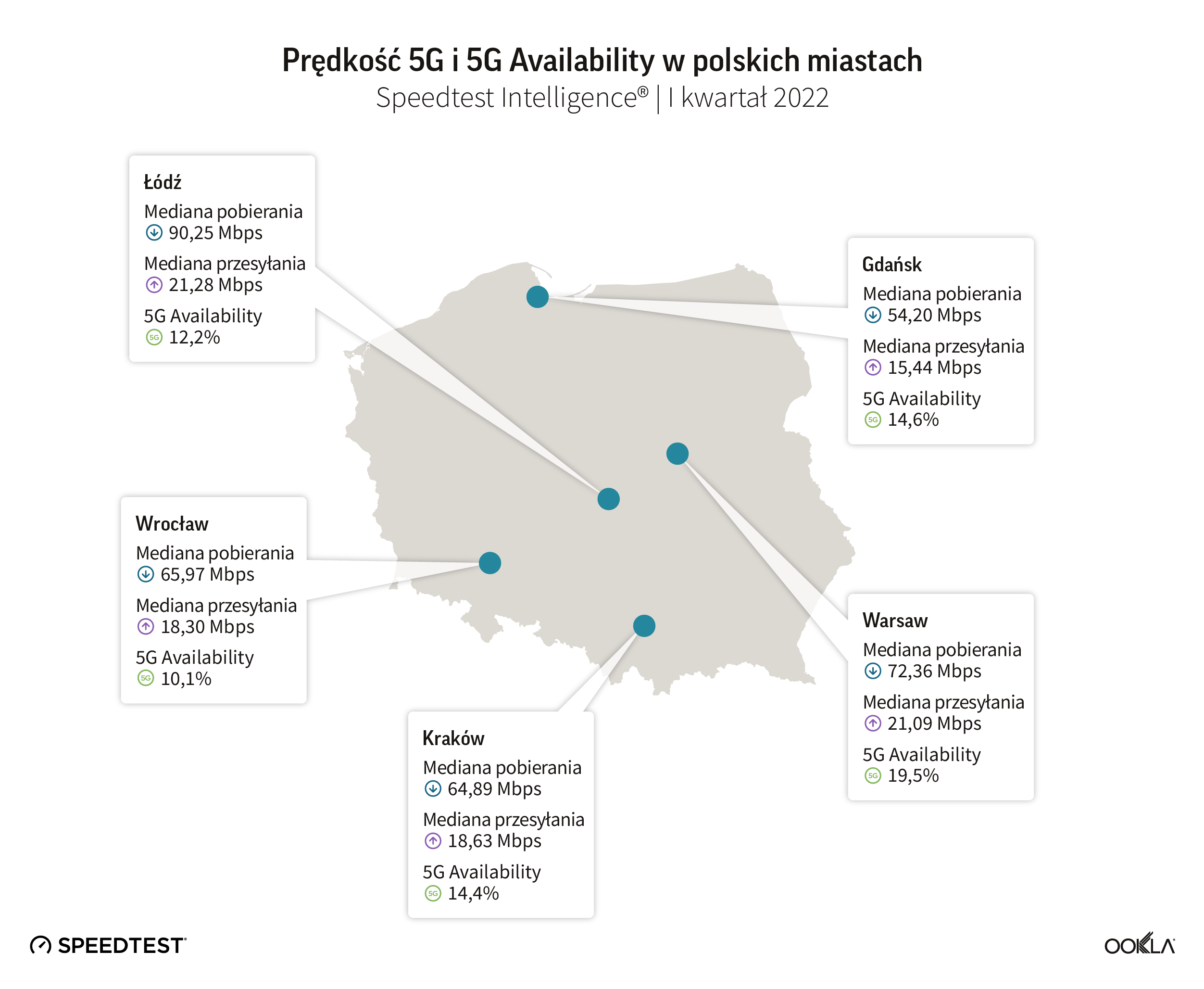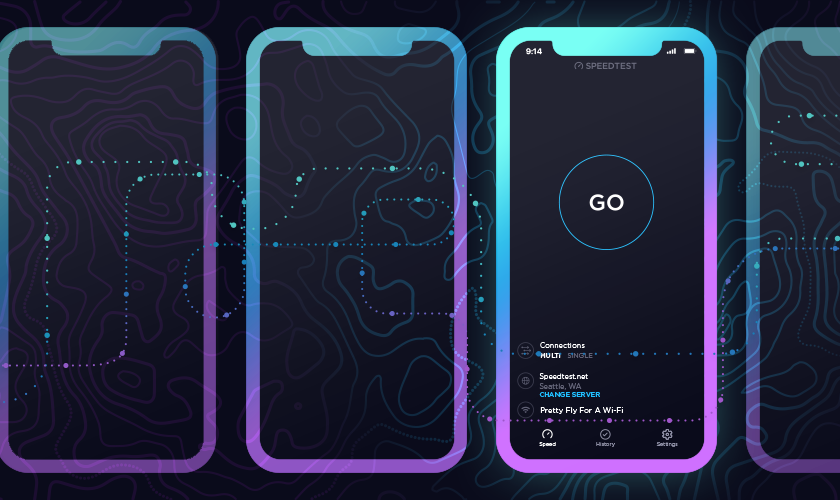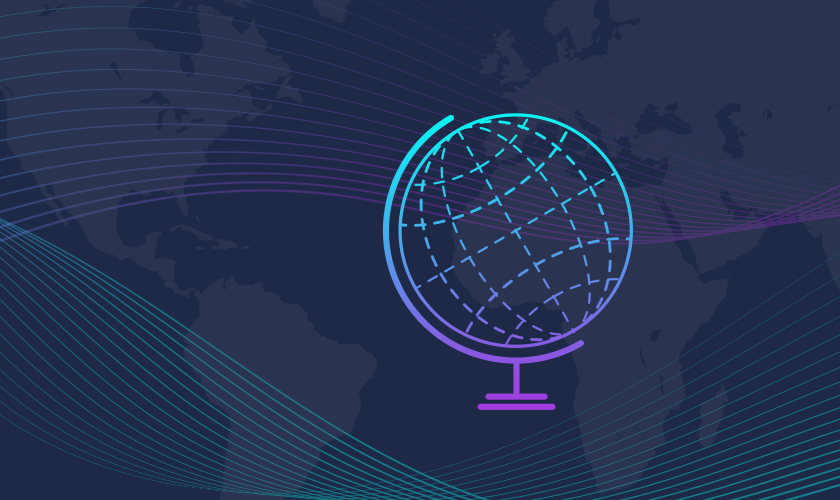
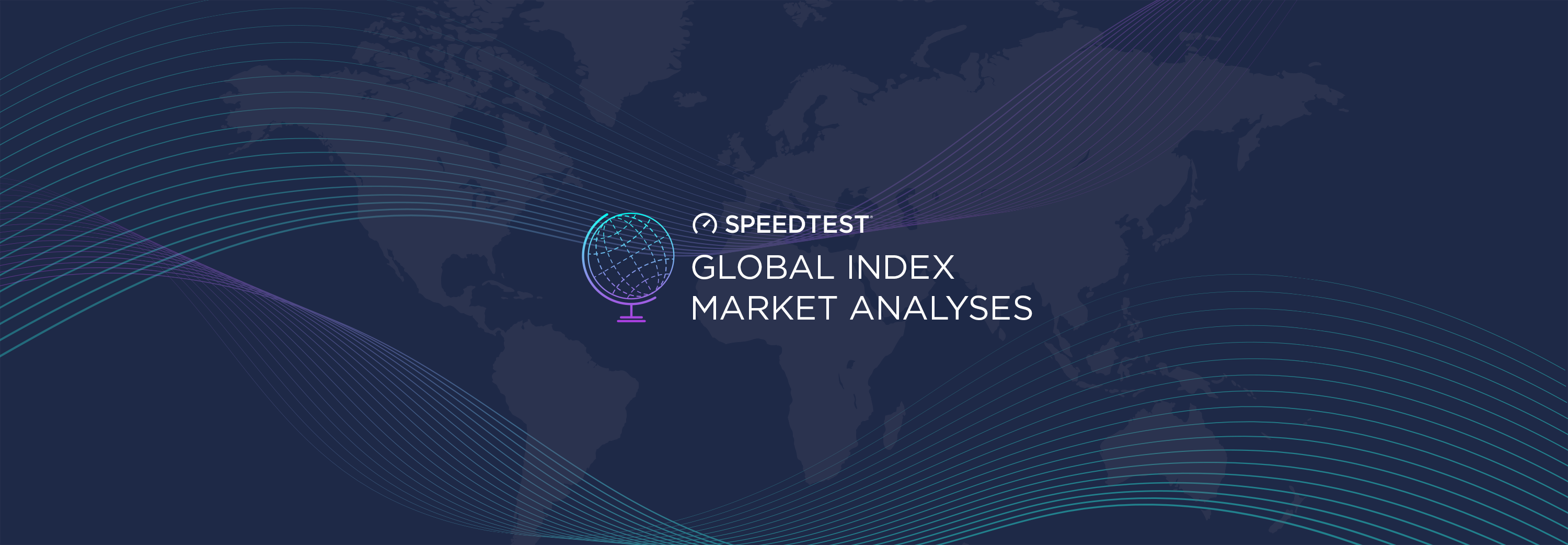
Speedtest Global IndexTM Market Analyses from Ookla® identify key data about internet performance in countries across the world. This quarter we’ve provided updated analyses for 43 markets that includes details on fastest mobile and fixed broadband providers, performance of most popular devices and chipsets and internet speeds in cities. Click a country on the list below to see highlights or scroll through the article to learn what Speedtest Intelligence® revealed in all 43 markets:
Africa and the Middle East
Asia and Oceania
Europe
North and South America
Africa and the Middle East
Algeria
- Mobile provider Ooredoo had the highest Speed Score™ (25.69) and Consistency Score™ (83.4%) in Algeria during Q3 2021.
- Apple devices were the fastest devices in Algeria during Q3 2021, achieving a mean download speed of 27.53 Mbps.
- The Apple iPhone 12 Pro Max 5G was the fastest popular device in Algeria for the second quarter in a row with a mean download speed of 39.66 Mbps.
- Apple devices took four out of the top five spots among popular devices, with Xiaomi’s Redmi K40 5G taking the runner-up spot on this list at 35.78 Mbps.
Jordan
- Speedtest Intelligence found Umniah was the fastest mobile operator in Jordan during Q3 2021, earning a Speed Score of 35.86.
- Umniah also had the highest Consistency Score at 93.9%.
- For the second quarter in a row, fixed broadband provider Orange had the fastest Speed Score (77.30).
- Fixed broadband provider DAMAMAX overtook Orange for the highest Consistency Score at 86.5%.
- Among popular mobile devices, Apple’s iPhone 12 5G narrowly beat out the iPhone 12 Pro 5G for fastest median download and upload speeds at 39.43 Mbps and 18.73 Mbps, respectively.
- Amman had the fastest median fixed broadband and mobile download speeds among Jordan’s most populous cities at 51.12 Mbps and 19.46 Mbps, respectively.
Kenya
- Mobile provider Safaricom had the highest Speed Score (29.20) and Consistency Score (85.0%) in Kenya during Q3 2021.
- For fixed broadband, Faiba had the highest Speed Score (26.47) and Consistency Score (48.7%) in Kenya for the second quarter in a row during Q3 2021.
- Mombasa had the fastest mean mobile download and upload speeds among Kenya’s most populous cities at 28.25 Mbps and 16.26 Mbps, respectively.
- Mombasa overtook Eldoret as the city with the fastest median fixed broadband download speed at 22.61 Mbps during Q3 2021.
Morocco
- Mobile operator Maroc Telecom achieved the highest Speed Score (56.99) and Consistency Score (90.9%) during Q3 2021, both slight dips from Q2 2021 results.
- Marrakesh regained the top spot during Q3 2021 as the fastest city among Morocco’s most populous cities with a mean mobile download speed at 40.69 Mbps. Fes and Salé were close at 40.25 Mbps and 40.15 Mbps, respectively.
Nigeria
- For the third quarter in a row, mobile provider Airtel had the fastest Speed Score in Nigeria at 33.43 during Q3 2021 — a slight increase from 28.82 during Q2 2021.
- Airtel overtook MTN for the highest Consistency Score on mobile during Q3 2021 at 89.4% to MTN’s 82.7%.
- Fixed broadband provider ipNX had the best Speed Score (21.66) and Consistency Score (40.2%) in Nigeria during Q3 2021.
- The iPhone 12 Pro Max 5G was the fastest popular device in Nigeria during Q3 2021, achieving a mean download speed of 41.94 Mbps — just faster than the iPhone 12 Pro 5G (41.37 Mbps).
- Kano took the top spot among Nigeria’s most populous cities for fastest mean mobile download speed at 24.76 Mbps during Q3 2021.
Qatar
- Ooredoo had the best Speed Score over mobile and fixed broadband in Qatar for the second quarter in a row during Q3 2021 at 145.53 and 71.36, respectively.
- 5G performance was extremely competitive with Ooredoo achieving the fastest median 5G download speed at 373.98 Mbps and Vodafone achieving 346.91 Mbps.
- Ooredoo had the highest fixed broadband Consistency Score at 81.8%.
- Vodafone had the highest mobile Consistency Score at 93.8%, edging out Ooredoo’s 91.4%.
- Al Khor had the fastest median mobile download speed among Qatar’s most populous cities during Q3 2021 at 135.79 Mbps.
- Umm Salal Muhammed had the fastest fixed broadband download speeds in Qatar at 83.41 Mbps.
- Speedtest Intelligence reveals that among popular devices in Qatar during Q3 2021, Samsung’s Galaxy S21 Ultra 5G achieved the fastest median mobile download speed at 330.68 Mbps, a significant increase from Q2 2021’s 284.32 Mbps.
South Africa
- Speedtest Intelligence shows Cool Ideas had the fastest fixed broadband Speed Score (53.85) and Consistency Score (73.0%) for the second quarter in a row during Q3 2021.
- Among mobile operators, MTN had the fastest Speed Score (63.52) and highest Consistency Score (91.0%).
- Apple devices had the fastest combined median download speed in South Africa at 38.24 Mbps and fastest median upload speed at 8.11 Mbps during Q3 2021.
- The iPhone 12 Pro Max 5G took top honors as the fastest popular device, achieving a median download speed of 79.56 Mbps.
Tunisia
- During Q3 2021, Ooredoo achieved the highest mobile Speed Score in Tunisia at 44.06, a slight dip from Q2 2021.
- Tunisie Telecom had the highest fixed broadband Speed Score at 9.31.
- Apple’s iPhone 12 Pro Max 5G had the fastest mean download speed in Tunisia among popular devices during Q3 2021 at 64.43 Mbps.
- Among popular chipsets, Qualcomm’s Snapdragon X55 5G had the fastest mean download speed for the second quarter in a row at 62.92 Mbps.
- Sfax had the fastest mean mobile download speed in Tunisia for the second quarter in a row at 47.02 Mbps.
Turkey
- Speedtest Intelligence revealed mobile provider Turkcell had the highest Speed Score and Consistency Score in Turkey during Q3 2021 at 67.19 and 93.3%, respectively. Both scores were slight increases from Q2 2021.
- For fixed broadband, TurkNet edged out Turksat Kablo for the highest Speed Score 38.14 to 37.57.
- Turknet also had the highest Consistency Score for fixed broadband at 72.3% during Q3 2021.
- Istanbul had the fastest mean fixed broadband and mobile download speed at 48.34 Mbps and 56.43 Mbps, respectively.
- Among top device manufacturers, Apple beat out Samsung for fastest mean download speed at 55.72 Mbps to 43.52 Mbps, respectively.
Asia and Oceania
Australia
- Aussie Broadband was the fastest fixed broadband provider in Australia, earning a Speed Score of 88.33 during Q3 2021.
- Aussie Broadband also had the highest Consistency Score, edging out Vodafone 85.7% to 83.2%.
- Competition for the fastest fixed broadband speed among Australia’s most populous cities was extremely tight, with seven cities achieving between 49.00 Mbps and 53.00 Mbps. Melbourne(52.53 Mbps) edged out Darwin (52.42 Mbps), Brisbane (52.41 Mbps) and Sydney (52.30 Mbps).
China
- According to Speedtest Intelligence, China Telecom was the fastest fixed broadband provider in China during Q3 2021 with a Speed Score of 129.56, a moderate gain over Q2 2021.
- China Mobile continued to have the highest Consistency Score in China for fixed broadband during Q3 2021 at 90.3%, edging out China Telecom’s 88.4% and China Unicom’s 87.8%.
- On mobile, China Mobile achieved the highest Speed Score (141.55) and Consistency Score (92.7%) among China’s top providers during Q3 2021.
- During Q3 2021, China Telecom achieved a median 5G download speed of 304.03 Mbps, edging out China Mobile’s 302.99 Mbps.
- Among top device manufacturers, Huawei had the fastest median download speed at 96.66 Mbps in China during Q3 2021 — a gain over Q2 2021. OnePlus followed at 85.92 Mbps, then Oppo (82.26 Mbps), Samsung (78.00 Mbps) and Vivo (66.97 Mbps).
- Among popular devices, the Apple iPhone 13 Pro Max edged out Huawei’s Mate 40 Pro 5G for the fastest median download speed in China during Q3 2021 at 290.23 Mbps to 280.22 Mbps.
- During Q3 2021, MediaTek’s Dimensity 700 5G chipset had the fastest median download speed at 295.51 Mbps, supplanting Huawei’s Kirin 9000 5G as the fastest chipset in China.
- Tianjin once again had the fastest median fixed broadband download speed among China’s most populous cities at 215.33 Mbps, a moderate rise from its Q2 2021 results.
- Harbin had the fastest median mobile download speed among China’s most populous cities at 92.34 Mbps, edging out Shenzhen’s 92.17 Mbps. This was a noticeable rise from Q2 2021 when Hangzhou was the fastest at 72.97 Mbps.
Hong Kong (SAR)
- China Mobile Hong Kong was the fastest mobile operator in Hong Kong for the third quarter in a row, earning a Speed Score of 74.49 in Q3 2021.
- China Mobile Hong Kong once again blazed ahead of the competition for the fastest 5G download speed, achieving a median speed of 191.95 Mbps during Q3 2021, a decline from its Q2 2021 results. Mobile provider 3 followed at 165.12 Mbps, then SmarTone at 147.10 Mbps and csl at 121.60 Mbps.
- Among top manufacturers during Q3 2021, Samsung had the fastest median download speed at 44.64 Mbps, edging out Apple’s median download speed of 43.20 Mbps.
- During Q3 2021, the iPhone 13 Pro Max took the top spot among popular devices in Hong Kong with a median download speed of 125.92 Mbps.
- Qualcomm’s Snapdragon X60 5G was the fastest modern chipset for median download speed during Q3 2021 at 122.84 Mbps.
Indonesia
- According to Speedtest Intelligence, Biznet was once again Indonesia’s fastest fixed broadband provider during Q3 2021, earning a Speed Score of 42.17.
- Biznet also had the highest fixed broadband Consistency Score in Indonesia during Q3 2021, edging out MyRepublic 68.3% to 63.5%.
- Telkomsel was the fastest major mobile operator in Indonesia during Q3 2021, earning a Speed Score of 30.49. Telkomsel also achieved the top Consistency Score at 85.7%, beating out XL (82.7%) and IM3 Ooredoo (82.6%).
- The Apple iPhone 12 Pro Max 5G edged out the Xiaomi Redmi K40 5G as the fastest popular device with a mean download speed of 44.95 Mbps to 43.18 Mbps.
- Jakarta had the fastest mean fixed broadband download speed of Indonesia’s most populous cities at 33.73 Mbps, while Makassar achieved the fastest mean mobile download speed at 25.30 Mbps.
Malaysia
- Speedtest Intelligence reveals that TIME was the fastest fixed broadband provider in Malaysia during Q3 2021, earning a Speed Score of 120.10. TIME also achieved the highest Consistency Score for fixed broadband at 87.6%.
- On mobile, Digi edged out Maxis for the fastest mobile operator in Malaysia, earning a Speed Score of 33.19 to Maxis’ 31.94 during Q3 2021.
- Apple devices showed the fastest speed in Malaysia during Q3 2021 with a mean download speed of 37.51 Mbps.
- Competition was fierce among popular devices in Malaysia during Q3 2021, with the Apple iPhone 12 Pro 5G edging out the iPhone 12 Pro Max 5G at 55.06 Mbps to 54.78 Mbps. The iPhone 12 5G followed at 54.22 Mbps and then the Xiaomi Redmi K40 5G (54.20 Mbps).
- Among Malaysia’s most populous cities, Petaling Jaya had the fastest mean fixed broadband speed during Q3 2021, achieving a 129.74 Mbps download and a 89.11 Mbps upload.
- Nusajaya had the fastest mean mobile download speed at 38.08 Mbps during Q3 2021.
New Zealand
- During Q3 2021, Vodafone was the fastest mobile operator in New Zealand, earning a Speed Score of 68.79.
- Vodafone also achieved the fastest median 5G download speed at 326.44 Mbps. Spark was second at 266.75 Mbps.
- The Apple iPhone 12 5G was very slightly ahead of the iPhone 12 Pro 5G for fastest median download among popular devices in New Zealand with 92.96 Mbps to 92.70 Mbps, respectively, during Q3 2021.
- Among popular device manufacturers, Oppo edged out Apple for the fastest median download speed in New Zealand during Q3 2021, 44.00 Mbps to 43.47 Mbps.
- Christchurch had the fastest median mobile download speed at 52.16 Mbps.
Philippines
- During Q3 2021, Smart had the highest Speed Score (59.71) among top mobile operators in the Philippines.
- Smart had the fastest median 5G download speed in the Philippines during Q3 2021 at 217.03 Mbps, nearly twice as fast as Globe’s 114.12 Mbps.
- Competition for the fastest popular device was tight during Q3 2021, with all of the top five devices achieving median download speeds between 72.00 and 76.00 Mbps. However, Apple’s iPhone 12 Pro 5G edged out the iPhone Pro Max 5G at 75.27 Mbps to 74.68 Mbps.
- Caloocan had the fastest median download speed among the Philippines’ most populous cities at 22.05 Mbps.
Singapore
- Speedtest Intelligence shows ViewQuest was the fastest fixed broadband provider in Singapore in Q3 2021, achieving a Speed Score of 276.23. MyRepublic, SingTel and StarHub all achieved a Speed Score above 200.00, while M1 followed at 183.83.
- Singtel was the fastest mobile provider in Singapore during Q3 2021, achieving a Speed Score of 99.74, a moderate rise from Q2 2021.
- Singtel also blazed ahead of the competition for fastest median 5G download speed at 248.45 Mbps during Q3 2021 — a noticeable rise from Q2 2021.
- The Apple iPhone 13 Pro Max was the fastest popular device in Singapore during Q3 2021, achieving a median download speed of 164.40 Mbps.
- Apple beat out Samsung for fastest device manufacturer during Q3 2021, with Apple devices in Singapore achieving a median download speed of 71.98 Mbps to Samsung’s 63.73 Mbps.
Taiwan
- During Q3 2021, Chunghwa Telecom had the fastest median 5G download speed in Taiwan at 440.93 Mbps. FarEasTone followed at 335.17 Mbps, then Taiwan Mobile (262.99 Mbps) and TSTAR (138.51 Mbps).
- FarEasTone had the highest Consistency Score in Taiwan during Q3 2021 at 92.8%.
- Among top device manufacturers during Q3 2021, Apple devices achieved the fastest median download speed in Taiwan at 50.25 Mbps.
- The Apple iPhone 13 Pro Max had the fastest median download speed among popular devices in Taiwan at 200.90 Mbps.
Vietnam
- Viettel again claimed the top spot as Vietnam’s fastest mobile and fixed broadband provider during Q3 2021, earning a mobile Speed Score of 46.33 and fixed broadband Speed Score of 68.01.
- Vinaphone had the highest mobile Consistency Score in Vietnam during Q3 2021 at 94.7%.
- Apple’s iPhone 12 Pro Max 5G had the fastest median download speed among popular devices in Vietnam during Q3 2021 at 62.67 Mbps, edging out the iPhone 12 5G (61.24 Mbps) and iPhone 12 Pro 5G (61.22 Mbps).
- Ho Chi Minh City took the top spot for the fastest median fixed broadband download speed among Vietnam’s most populous cities with 65.63 Mbps (63.05 Mbps upload).
- Da Nang took the top spot for fastest median mobile download speed among Vietnam’s most populous cities at 42.66 Mbps during Q3 2021.
Europe
Austria
- Magenta retained its top spot as Austria’s fastest fixed broadband provider with a Speed Score of 148.04 during Q3 2021. LIWEST was the closest competitor (83.34).
- Magenta also had the highest Consistency Score for fixed broadband at 88.4% in Q3 2021.
- A1 was again the fastest mobile provider in Austria during Q3 2021, achieving a Speed Score of 73.85. Operator 3 followed at 52.46.
- A1 had the highest mobile Consistency Score in Austria during Q3 2021 at 92.8%.
Belgium
- Telenet decisively claimed its spot as Belgium’s fastest fixed broadband provider during Q3 2021, earning a Speed Score of 123.84.
- Telenet had the highest fixed broadband Consistency Score at 88.0% during Q3 2021.
- Among mobile operators, BASE earned the fastest Speed Score in Belgium at 66.22, edging out Telenet (64.41) and Proximus (62.30).
- Once again, Ghent retained its top place for fastest median mobile download speed among Belgium’s most populous cities, achieving a median speed of 86.27 Mbps during Q3 2021.
- Ghent overtook Antwerp for the fastest median fixed broadband download speed at 81.05 Mbps to 79.89 Mbps, respectively.
Czechia
- Speedtest Intelligence reveals T-Mobile was Czechia’s fastest mobile provider during Q3 2021, earning a Speed Score of 58.82.
- Vodafone claimed the best mobile Consistency Score during Q3 2021, earning 93.0% to O2’s 90.3%.
- Vodafone dominated as Czechia’s fastest fixed broadband provider during Q3 2021, achieving a Speed Score of 92.47.
- Vodafone once again had Czechia’s highest Consistency Score for fixed broadband during Q3 2021 at 76.3%.
- Pilsen had the fastest median fixed broadband speed among Czechia’s most populous cities, achieving a median download of 53.40 Mbps, edging out Brno’s 52.74 Mbps.
- Brno had the fastest median mobile download speed at 69.68 Mbps, beating out Pilsen’s 66.66 Mbps.
Denmark
- Fastspeed was Denmark’s fastest fixed broadband provider during Q3 2021, earning a Speed Score of 303.91. Hiper followed at 245.03.
- Telenor supplanted YouSee as Denmark’s fastest mobile operator, earning a Speed Score of 88.48 to YouSee’s 85.01.
- An analysis of performance on some of the most popular phones in Denmark revealed the iPhone 13 Pro had the fastest median download speed during Q3 2021 at 124.21 Mbps.
Estonia
- According to Speedtest Intelligence, Elisa was the fastest fixed broadband provider in Estonia during Q3 2021, achieving a Speed Score of 84.47.
- Elisa also had the highest Consistency Score at 81.0%, edging out Infonet (77.7%).
- Telia had the fastest mobile Speed Score in Estonia during Q3 2021 at 78.26.
- The Apple iPhone 12 Pro 5G was the fastest popular device in Estonia, earning a median download speed of 100.94 Mbps. The iPhone 12 Pro Max 5G followed closely at 98.71 Mbps.
- Among major cell phone manufacturers, OnePlus had the fastest median download speed in Estonia during Q3 2021 at 59.91 Mbps.
Finland
- According to Speedtest Intelligence, DNA retained its top spot as Finland’s fastest mobile provider in Q3 2021, earning a Speed Score of 79.26. DNA also edged out Telia for the highest Consistency Score, achieving 92.5% to Telia’s 89.6%.
- Telia beat out Elisa and DNA in Q3 2021 for the fastest 5G download in Finland, achieving a median download speed of 283.34 Mbps to Elisa’s 231.45 Mbps and DNA’s 218.08 Mbps.
- Telia retained its top spot as the fastest fixed broadband provider in Finland during Q3 2021, earning a Speed Score of 94.56.
- Fixed broadband provider Elisa supplanted Telia in Q3 2021 for the highest Consistency Score at 82.2% to Telia’s 80.8%.
- Among popular device manufacturers, OnePlus had the fastest median download speed in Finland during Q3 2021 at 71.38 Mbps. However, the Apple iPhone 12 Pro Max 5G had the fastest median download speed among popular devices at 114.93 Mbps, edging out the Samsung Galaxy S21 Ultra 5G (113.96 Mbps).
France
- Speedtest Intelligence revealed a fierce competition for France’s fastest fixed broadband provider during Q3 2021, with Free narrowly edging out Bouygues with a Speed Score of 121.89 to 118.16.
- SFR achieved the highest fixed broadband Consistency Score in France during Q3 2021 at 68.1%.
- Orange once again earned the top spot as France’s fastest and most consistent mobile provider, earning a mobile Speed Score of 82.84 and a Consistency Score of 87.9%.
- During Q3 2021, Orange blew away the competition as France’s fastest 5G provider by achieving a median 5G download speed of 352.77 Mbps, slightly faster than Q2 2021. SFR followed at 205.19 Mbps.
- The Apple iPhone 12 Pro Max 5G was the fastest popular device in France during Q3 2021, edging out the iPhone 12 Pro 5G with a median download speed of 103.71 Mbps to 102.21 Mbps.
- During Q3 2021, Lyon achieved the fastest median fixed broadband download and upload speeds at 151.09 Mbps and 102.62 Mbps, respectively. Nice had the fastest median mobile download speed at 78.19 Mbps.
Germany
- According to Speedtest Intelligence, Vodafone was once again Germany’s fastest fixed broadband provider during Q3 2021, earning a Speed Score of 126.45.
- Vodafone also took the top spot among fixed broadband providers for highest Consistency Score at 80.2%.
- Telekom achieved the highest Speed Score (80.92) and Consistency Score (90.1%) among German mobile operators during Q3 2021.
- Telekom supplanted O2 for the fastest median 5G download speed in Germany with 161.14 Mbps and 157.55 Mbps, respectively, during Q3 2021.
- The iPhone 13 Pro Max had the fastest median download speed among popular devices in Germany during Q3 2021, edging out the iPhone 13 Pro with 138.74 Mbps to 134.41 Mbps.
Hungary
- Vodafone retained its top spot as Hungary’s fastest fixed broadband provider in Q3 2021, edging out DIGI with a Speed Score of 153.79 to 148.05. Vodafone retained the top spot for highest Consistency Score at 86.6% during Q3 2021.
- Magyar Telekom retained its top spot as Hungary’s fastest and most consistent mobile provider during Q3 2021, earning a Speed Score of 52.30 and Consistency Score of 89.0%.
- Apple devices took the top spot among major device manufacturers in Q3 2021, achieving a median download speed of 41.09 Mbps in Hungary.
- The Samsung Galaxy S21 Ultra 5G edged out Apple’s iPhone 12 Pro Max 5G for the fastest median download speed among popular devices in Hungary during Q3 2021, 77.92 Mbps to 76.08 Mbps.
Latvia
- Speedtest Intelligence revealed that Balticom was once again the fastest and most consistent fixed broadband provider in Latvia during Q3 2021 achieving a Speed Score of 193.08 and Consistency Score of 90.7% — both slight increases over Q2 2021.
- LMT was the fastest mobile operator in Latvia during Q3 2021 with a Speed Score of 47.79.
- Tukums had the fastest median mobile download speed in Latvia at 50.02 Mbps during Q3 2021.
Luxembourg
- Tango retained its top spot as Luxembourg’s fastest fixed broadband provider during Q3 2021 by achieving a Speed Score of 126.48.
- POST was again the fastest mobile operator in Luxembourg during Q3 2021, achieving a small increase in Speed Score from 102.09 in Q2 2021 to 109.64 in Q3 2021.
- POST also remained the most consistent mobile operator in Luxembourg with a Consistency Score of 96.0%.
- Differdange achieved the fastest median fixed broadband download and upload speeds among Luxembourg’s most populous cities at 116.46 Mbps and 92.67 Mbps, respectively.
- Ettelbruck had the fastest median mobile download and upload speeds at 148.58 Mbps and 22.41 Mbps, respectively.
Malta
- Melita retained its top spot as Malta’s fastest and most consistent fixed broadband provider during Q3 2021, earning a Speed Score of 112.49 and Consistency Score of 82.9%.
Slovakia
- Orange knocked Telekom out of first place as Slovakia’s fastest mobile operator during Q3 2021 with a Speed Score of 55.57 to Telekom’s 53.63.
- Telekom had the highest mobile Consistency Score in Slovakia during Q3 2021 at 89.6%.
- UPC retained its top spot as Slovakia’s fastest and most consistent fixed broadband provider with a Speed Score of 139.98 and a Consistency Score of 86.6%.
- The Apple iPhone 12 Pro 5G had the fastest median download speed among popular devices in Slovakia at 67.29 Mbps during Q3 2021.
Spain
- Movistar provided the fastest and most consistent mobile experience among Spanish mobile providers with a Speed Score of 54.30 and Consistency Score of 88.5%.
- Vodafone was Spain’s fastest 5G provider by a wide margin during Q3 2021, achieving a median download speed of 323.13 Mbps.
- The Apple iPhone 12 Pro Max 5G had the fastest median download speed in Spain during Q3 2021 at 70.14 Mbps.
- During Q3 2021, Madrid had the fastest median mobile download speed at 41.85 Mbps. Barcelona followed at 38.58 Mbps.
North and South America
Argentina
- Speedtest Intelligence revealed Personal remained Argentina’s fastest mobile operator during Q3 2021 with a Speed Score of 40.08.
- Buenos Aires edged out La Plata for mobile download speeds in Argentina’s most populous cities with a median speed of 25.45 Mbps to La Plata’s 23.98 Mbps during Q3 2021.
Brazil
- Speedtest Intelligence reveals Claro remained the fastest and most consistent mobile operator in Brazil among top providers during Q3 2021, achieving a Speed Score of 44.76 and Consistency Score of 88.2%.
- There was no statistically fastest provider for median 5G download speed, though Claro showed 65.92 Mbps, Vivo 64.61 Mbps and TIM 58.14 Mbps.
- Among popular device manufacturers, Apple had the fastest median download speed in Brazil at 29.98 Mbps. Apple devices took four out of five of the top spots among popular devices in Brazil with the iPhone 12 5G achieving the fastest mean download speed at 53.28 Mbps.
- Brasília had the fastest median mobile download speed among Brazil’s most populous cities at 31.44 Mbps during Q3 2021.
Canada
- Shaw was Canada’s fastest fixed broadband provider in Q3 2021, earning a Speed Score of 184.26.
- Rogers edged out Shaw for the highest Consistency Score in Canada during Q3 2021 with 89.0% to Shaw’s 86.7%.
- TELUS retained its top spot as the fastest mobile operator in Canada during Q3 2021, achieving a Speed Score of 81.93.
- Videotron also retained its top spot during Q3 2021 as Canada’s most consistent mobile operator, achieving a Consistency Score of 87.4%.
- Competition for the fastest 5G was fierce during Q3 2021. Bell achieved the fastest median 5G download speed of 183.39 Mbps and TELUS followed at 176.38 Mbps.
- Rogers achieved the highest 5G Availability in Canada during Q3 2021 at 35.9%.
- Newfoundland and Labrador retained its top spot as Canada’s fastest region for fixed broadband during Q3 2021, achieving a median download speed of 124.22 Mbps. This province was also fastest for mobile.
- Calgary also retained its top spot among the most populous cities with the fastest median fixed broadband download speed at 134.33 Mbps. Halifax took the top spot for mobile download speed by a wide margin with a median download speed of 113.10 Mbps.
- Samsung devices had the fastest combined performance in Canada during Q3 2021, achieving a median download speed of 67.14 Mbps.
- The iPhone 13 Pro Max was the fastest popular device in Canada during Q3 2021, achieving a median download speed of 164.63 Mbps.
Chile
- According to Speedtest Intelligence, Claro was the fastest mobile operator in Chile with a Speed Score of 24.44 during Q3 2021. Claro also had the highest Consistency Score at 78.1%.
- The Samsung Galaxy S21 Ultra 5G had the fastest mean download speed among popular devices in Chile during Q3 2021 at 33.37 Mbps, edging out the iPhone 12 Mini 5G (32.25 Mbps).
- Among popular device manufacturers in Chile, Apple had the fastest mean download at 22.81 Mbps, a hair faster than Samsung’s 21.56 Mbps. Xioami, Motorola and Huawei followed.
- Temuco had the fastest mobile speeds in Chile during Q3 2021, achieving a mean download speed of 23.08 Mbps. Valparaíso and Viña del Mar were close followers at 22.97 Mbps and 22.59 Mbps, respectively.
Colombia
- Tigo was the fastest mobile operator in Colombia during Q3 2021, achieving a Speed Score of 26.21. WOM followed at 17.36. Tigo also had the highest Consistency Score at 85.5%.
- Among popular devices in Colombia during Q3 2021, the Apple iPhone 12 Pro Max 5G edged out the iPhone 12 Pro 5G for fastest mean download at 32.08 Mbps to 32.01 Mbps.
- Cartagena narrowly beat out Barranquilla for the fastest mean mobile download speed among Colombia’s most populous cities at 22.78 Mbps to 22.25 Mbps during Q3 2021.
Ecuador
- According to Speedtest Intelligence, Netlife was Ecuador’s fastest and most consistent fixed broadband provider during Q3 2021, achieving a Speed Score of 41.54 and Consistency Score of 73.0%.
- CNT was the fastest and most consistent mobile operator in Ecuador during Q3 2021, achieving a Speed Score of 41.65 and Consistency Score of 85.7%.
- During Q3 2021, the Apple iPhone 12 Pro Max 5G was the fastest popular device in Ecuador, achieving a mean download speed of 39.89 Mbps. Apple devices took all of the five top spots on this list.
- Quito had the fastest fixed broadband among Ecuador’s most populous cities during Q3 2021, achieving a mean download speed of 39.07 Mbps. This edged out Guayaquil’s mean download of 38.90 Mbps.
- Machala had the fastest mean mobile download speed in Ecuador during Q3 2021 at 27.28 Mbps.
Guatemala
- According to Speedtest Intelligence, Claro was the fastest and most consistent mobile operator in Guatemala during Q3 2021, achieving a Speed Score of 38.01 and Consistency Score of 89.2%.
- Tigo was the fastest and most consistent fixed broadband provider in Guatemala during Q3 2021 with a Speed Score of 19.97 and Consistency Score of 38.7%.
- The Apple iPhone 12 5G was the fastest popular device in Guatemala during Q3 2021, edging out the iPhone 12 Pro 5G with a mean download speed of 50.23 Mbps to the iPhone 12 Pro 5G’s 50.20 Mbps.
- Guatemala City had the fastest mean mobile download speed among Guatemala’s most populous cities at 31.11 Mbps.
- Villa Nueva had the fastest mean fixed broadband download speed at 29.78 Mbps.
Mexico
- Speedtest Intelligence reveals Telcel remained Mexico’s fastest mobile operator during Q3 2021, earning a Speed Score of 46.79.
- Telcel was also Mexico’s most consistent mobile operator, achieving a Consistency Score of 87.9% during Q3 2021.
- Totalplay was the fastest and most consistent fixed broadband provider in Mexico during Q3 2021, achieving a Speed Score of 46.24 and Consistency Score of 71.9%
- Apple devices had the five fastest mean download speeds among popular phones in Mexico during Q3 2021. The iPhone 12 Pro 5G narrowly beat out the iPhone 12 5G and iPhone 12 Pro Max 5G for the fastest popular device during Q3 2021, achieving respective speeds of 72.22 Mbps, 70.99 Mbps and 69.62 Mbps.
- Veracruz once again showed the fastest mean mobile download and upload speeds among Mexico’s most populous cities during Q3 2021, recording a speed of 45.76 Mbps and mean upload speed of 19.56 Mbps.
- Monterrey beat out Mexico City for the fastest fixed broadband download speed, earning a mean speed of 69.32 Mbps to Mexico City’s 65.39 Mbps.
Peru
- According to Speedtest Intelligence, Movistar was Peru’s fastest fixed broadband provider during Q3 2021, narrowly edging out Claro for fastest Speed Score with 44.39 to 42.22, respectively. Claro had the highest Consistency Score on fixed broadband during Q3 2021, beating out Movistar 72.9% to 65.9%.
- Claro was the fastest mobile operator in Peru during Q3 2021, earning a Speed Score of 34.05.
- Entel had the highest mobile Consistency Score in Peru during Q3 2021, narrowly edging out Claro at 78.1% to 77.4%.
- Among major device manufacturers, Apple devices achieved the fastest mean download speed by a wide margin in Peru during Q3 2021, achieving 40.32 Mbps to Samsung’s 23.90 Mbps.
United States
- Speedtest Intelligence reveals Verizon was once again the fastest fixed broadband provider in the United States during Q3 2021, earning a Speed Score of 178.38.
- T-Mobile was once again the fastest and most consistent mobile operator in the U.S. during Q3 2021, achieving a median download speed of 62.35 Mbps and a Consistency Score of 84.4%.
- Looking at tests taken only on 5G, T-Mobile achieved the fastest median 5G download speed during Q3 2021 at 135.17 Mbps — a significant increase from 99.84 Mbps during Q2 2021.
- During Q3 2021, T-Mobile had the best 5G Availability in the U.S. at 64.4%.
- Competition for the highest 5G Consistency was extremely close in the U.S. during Q3 2021, with Verizon Wireless achieving a 5G Consistency Score of 78.8%, T-Mobile 78.4% and AT&T 73.8%.
- The recently released iPhone 13 Pro Max and iPhone 13 Pro blazed ahead of the competition for fastest popular device in the U.S. during Q3 2021, achieving median download speeds of 95.96 Mbps and 94.72 Mbps, respectively. The Samsung Galaxy Z Fold3 5G was next at 83.81 Mbps.
- Pittsburgh, Pennsylvania had the fastest median mobile download speed in the U.S. during Q3 2021 at 82.94 Mbps.
- Austin, Texas had the fastest fixed broadband speed among the U.S.’s most populous cities during Q3 2021, achieving a median download speed of 196.28 Mbps.
Read the full market analyses and follow monthly ranking updates on the Speedtest Global Index.
Ookla retains ownership of this article including all of the intellectual property rights, data, content graphs and analysis. This article may not be quoted, reproduced, distributed or published for any commercial purpose without prior consent. Members of the press and others using the findings in this article for non-commercial purposes are welcome to publicly share and link to report information with attribution to Ookla.



